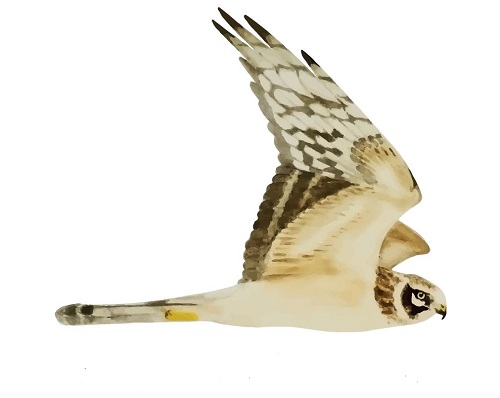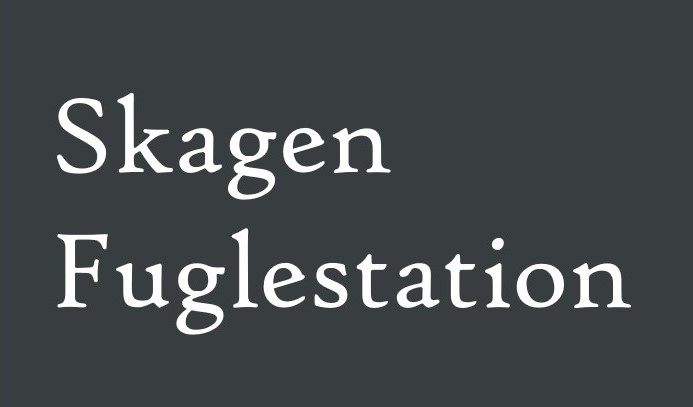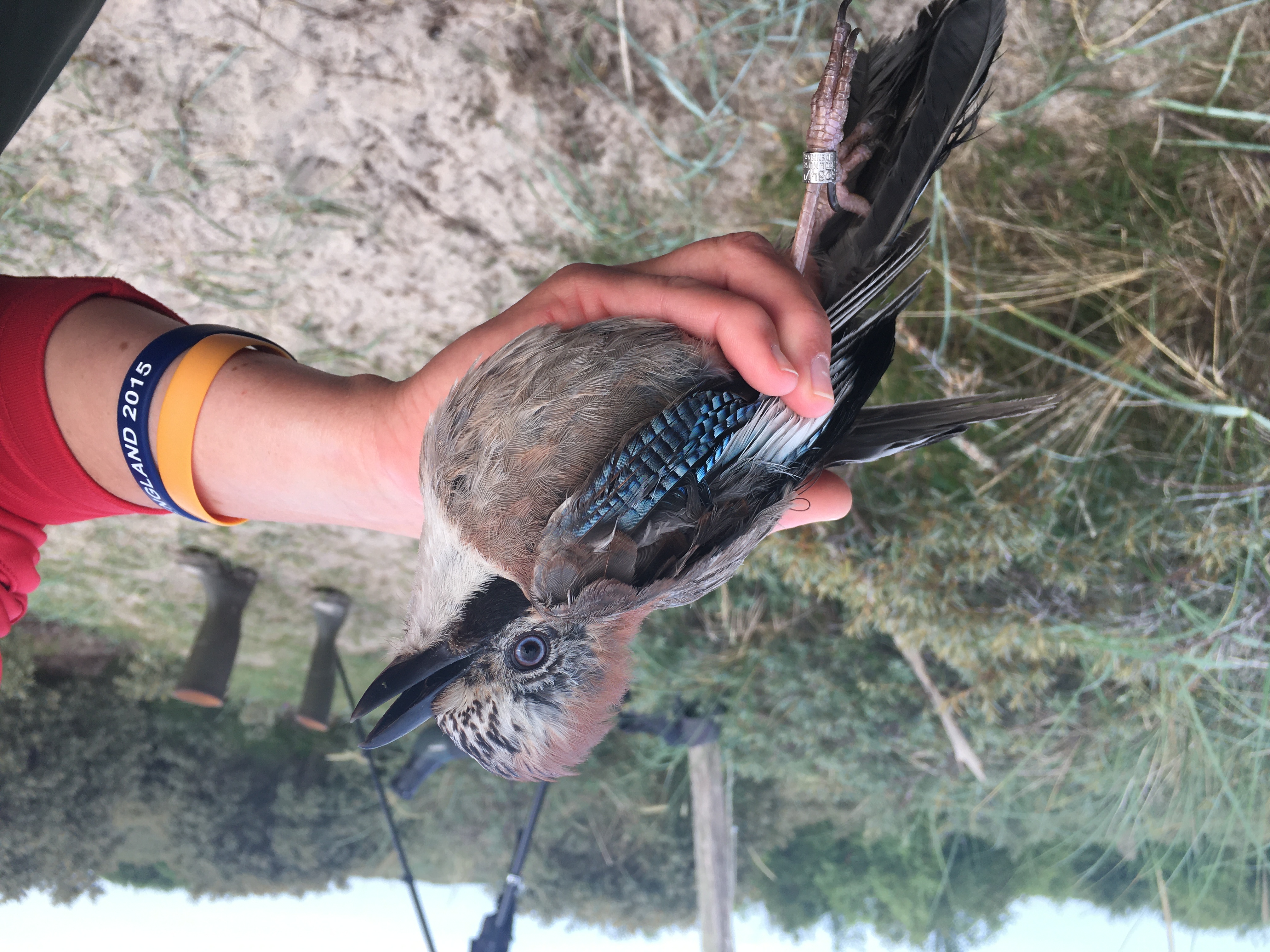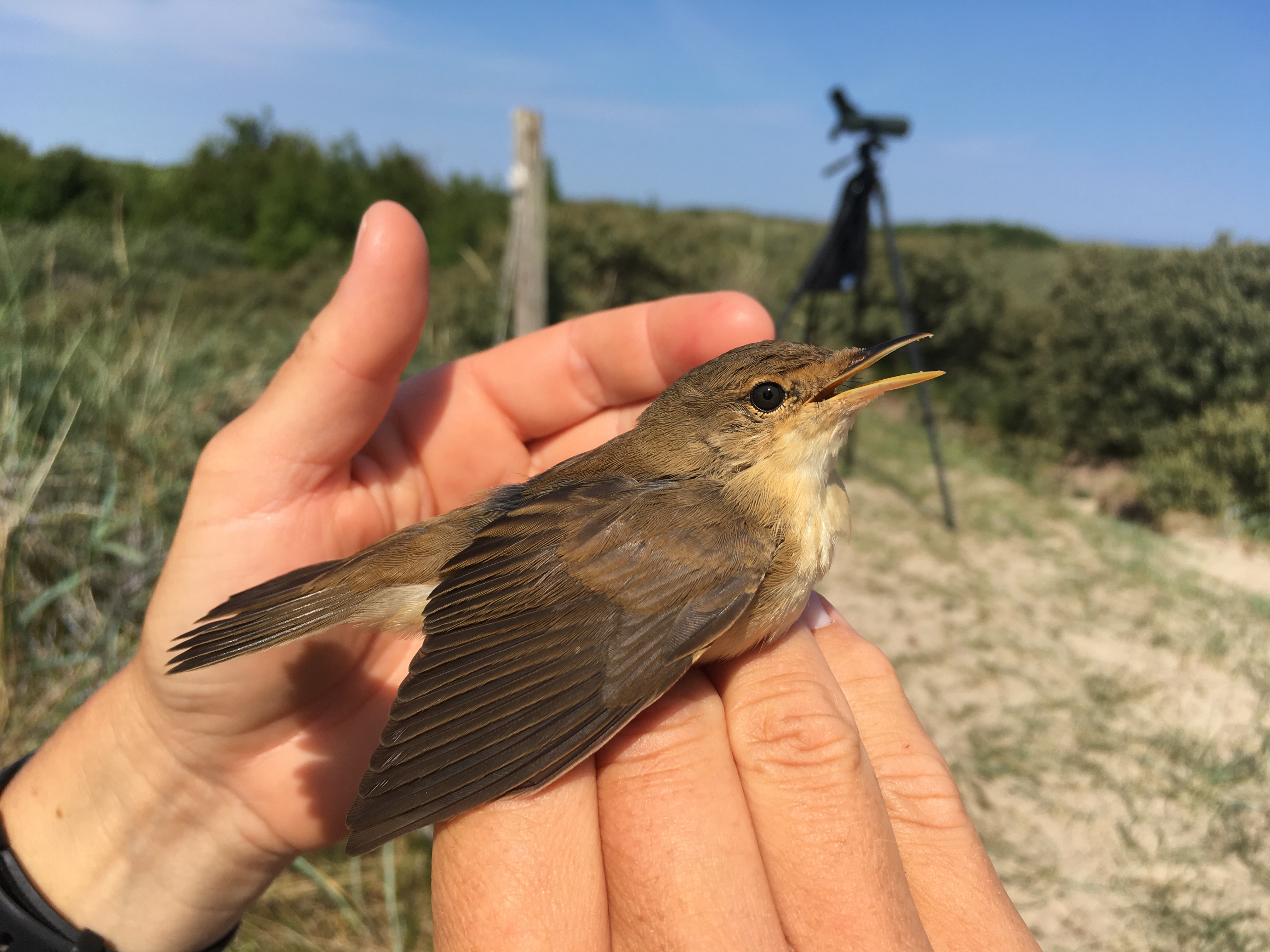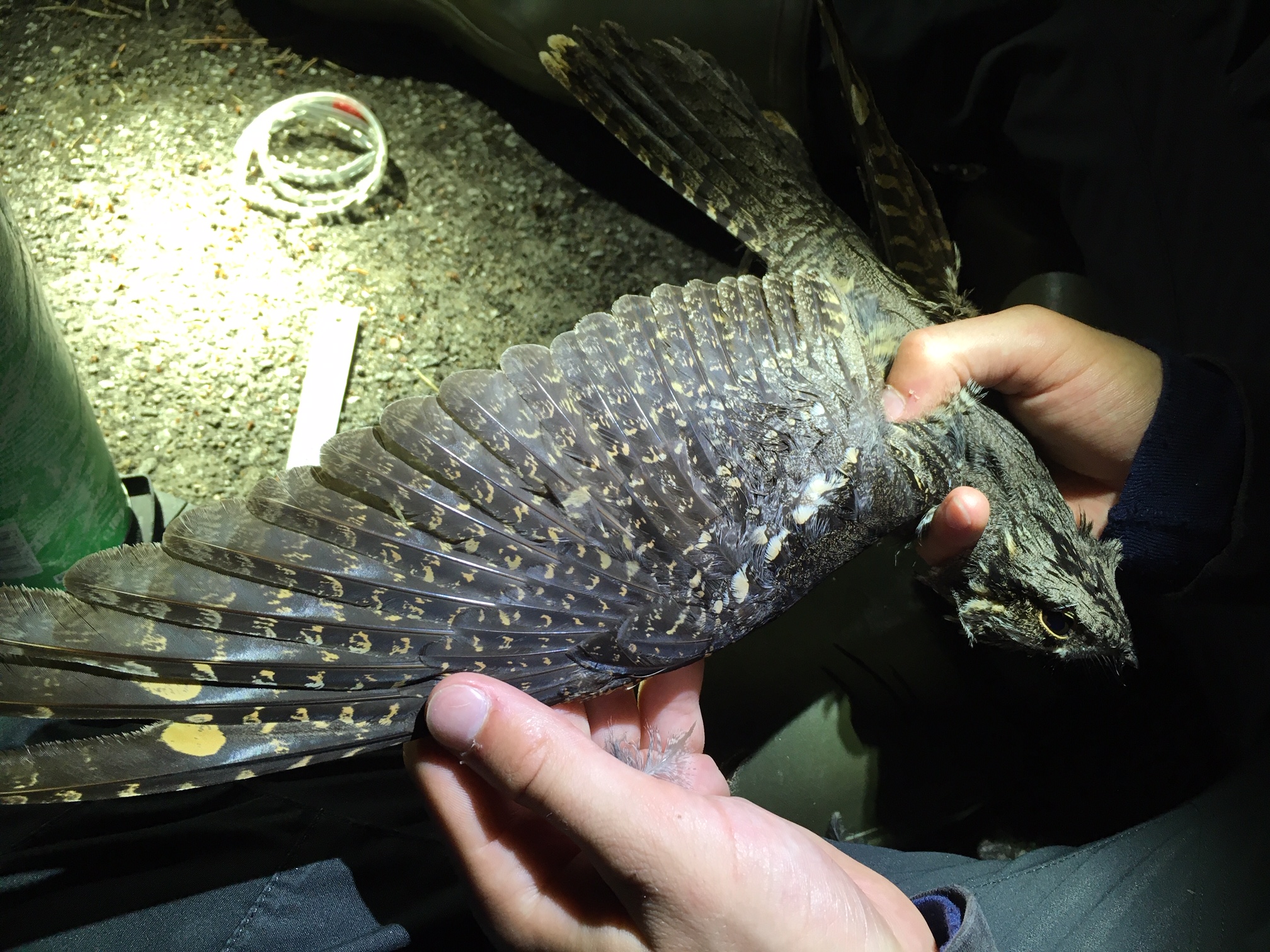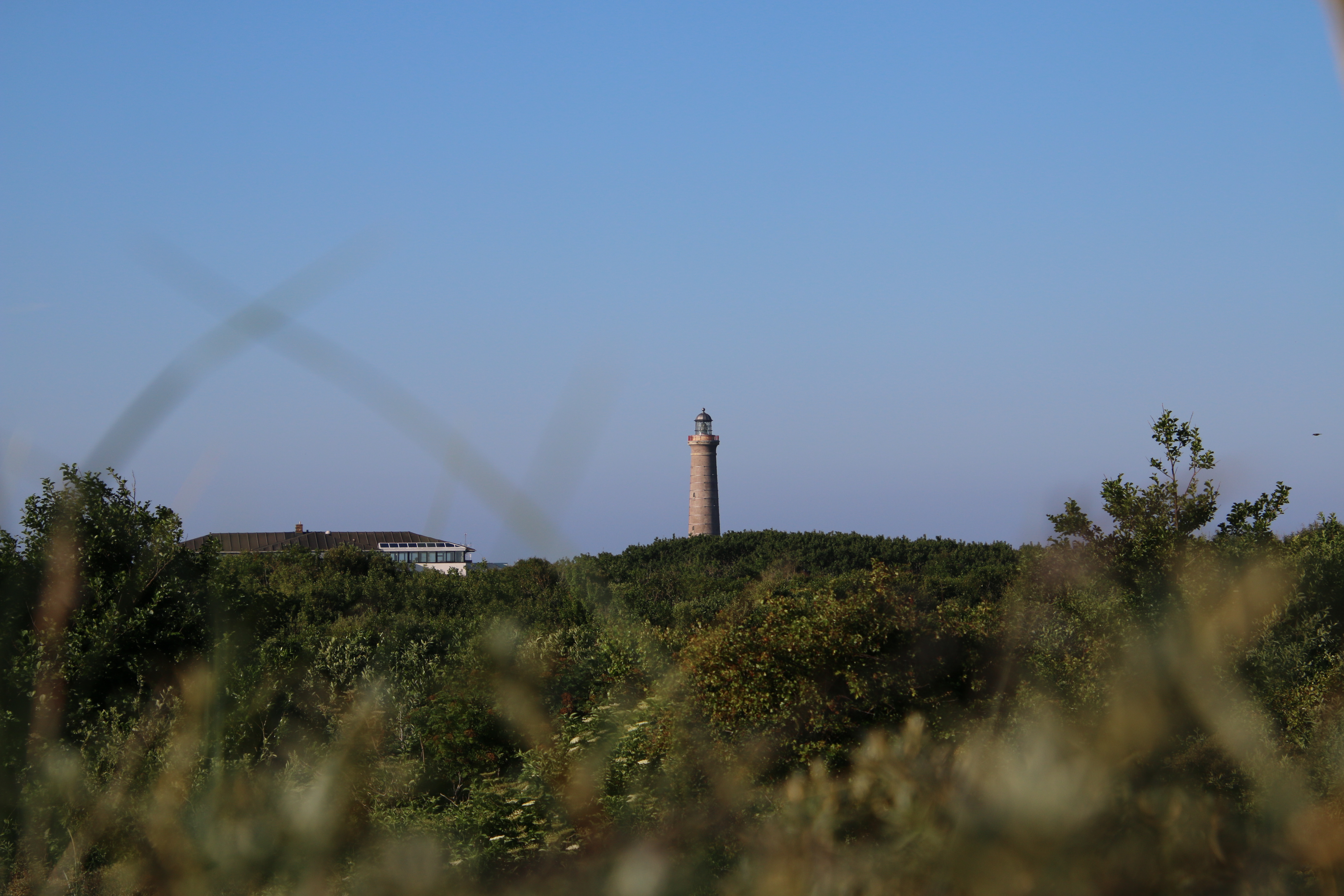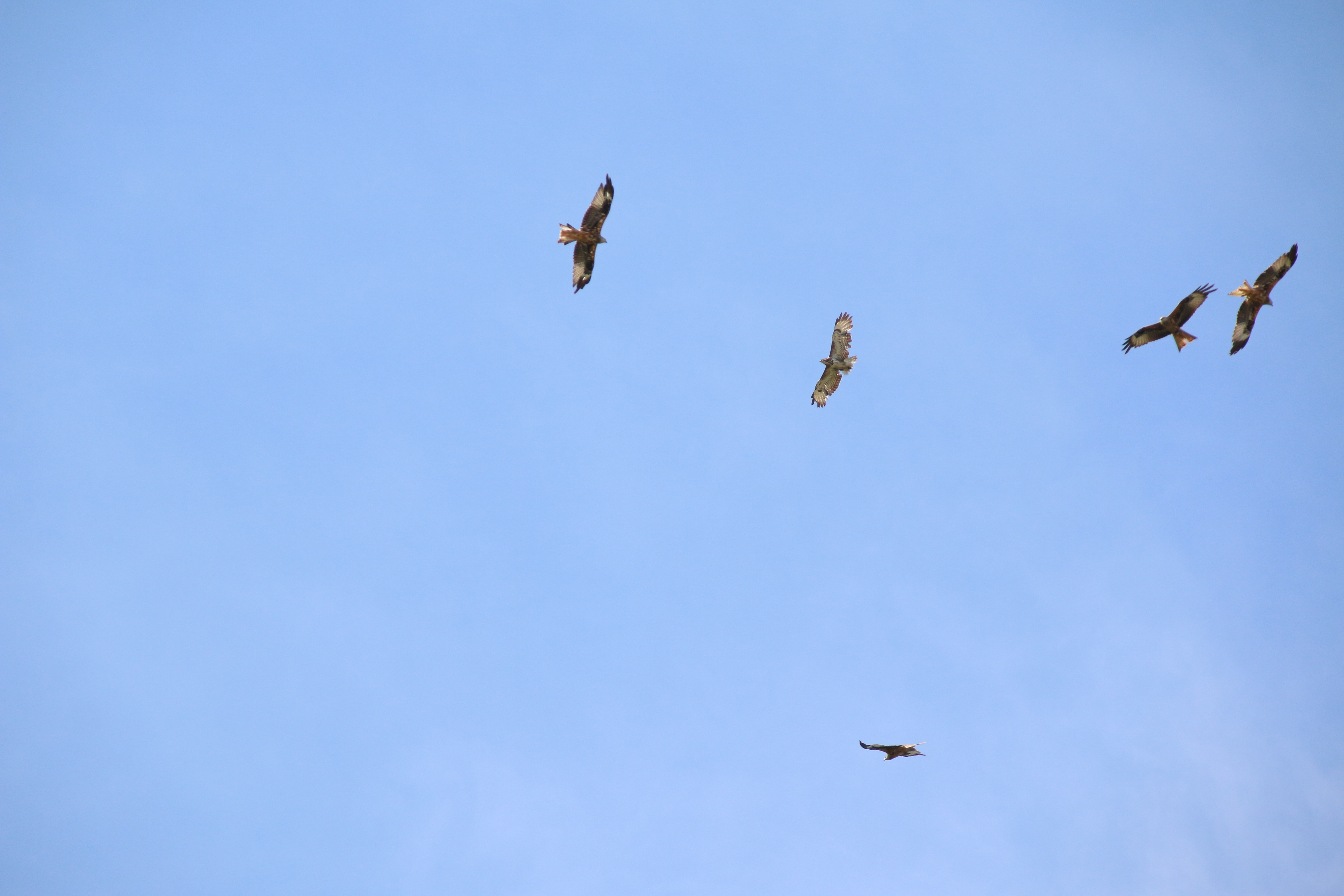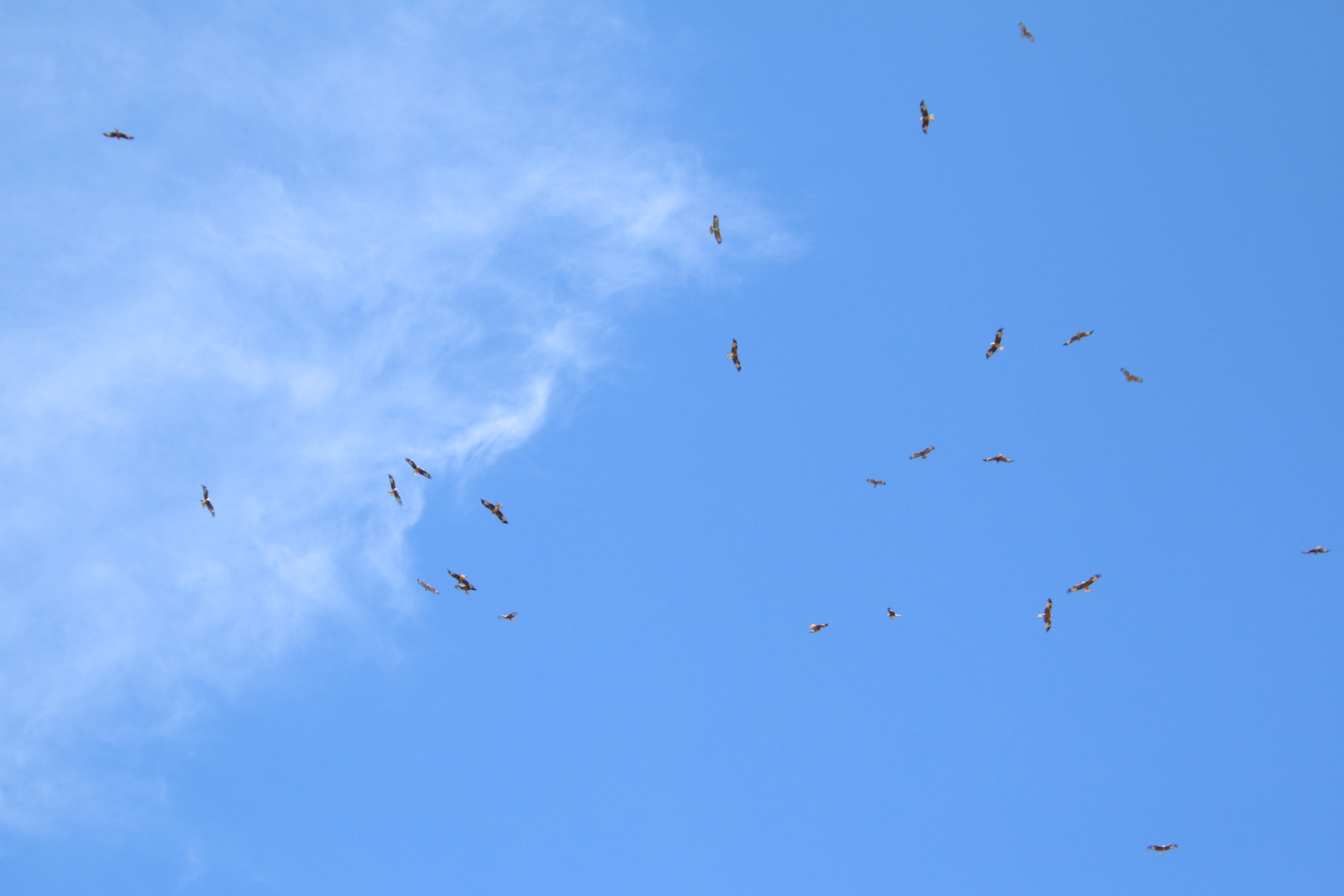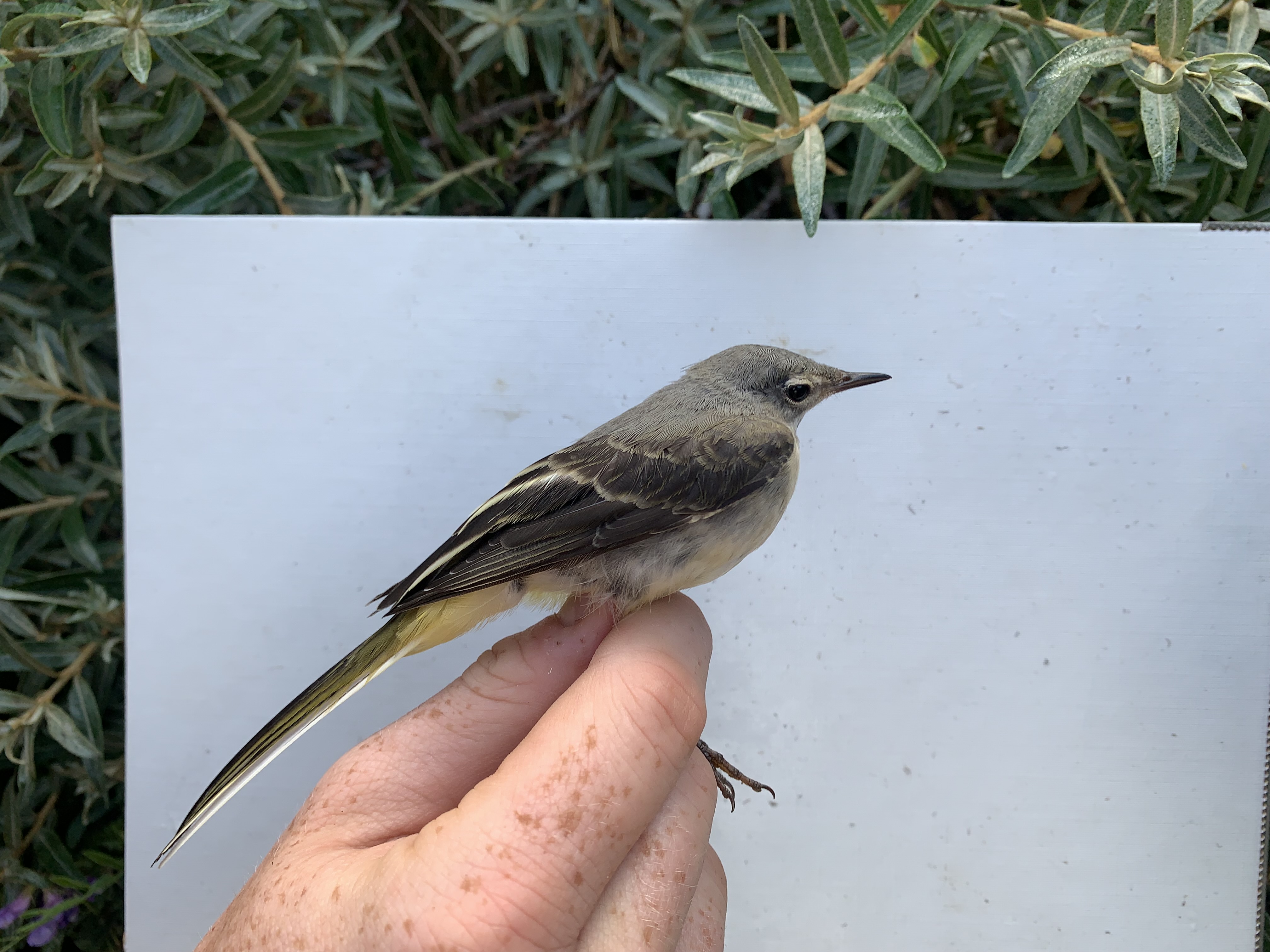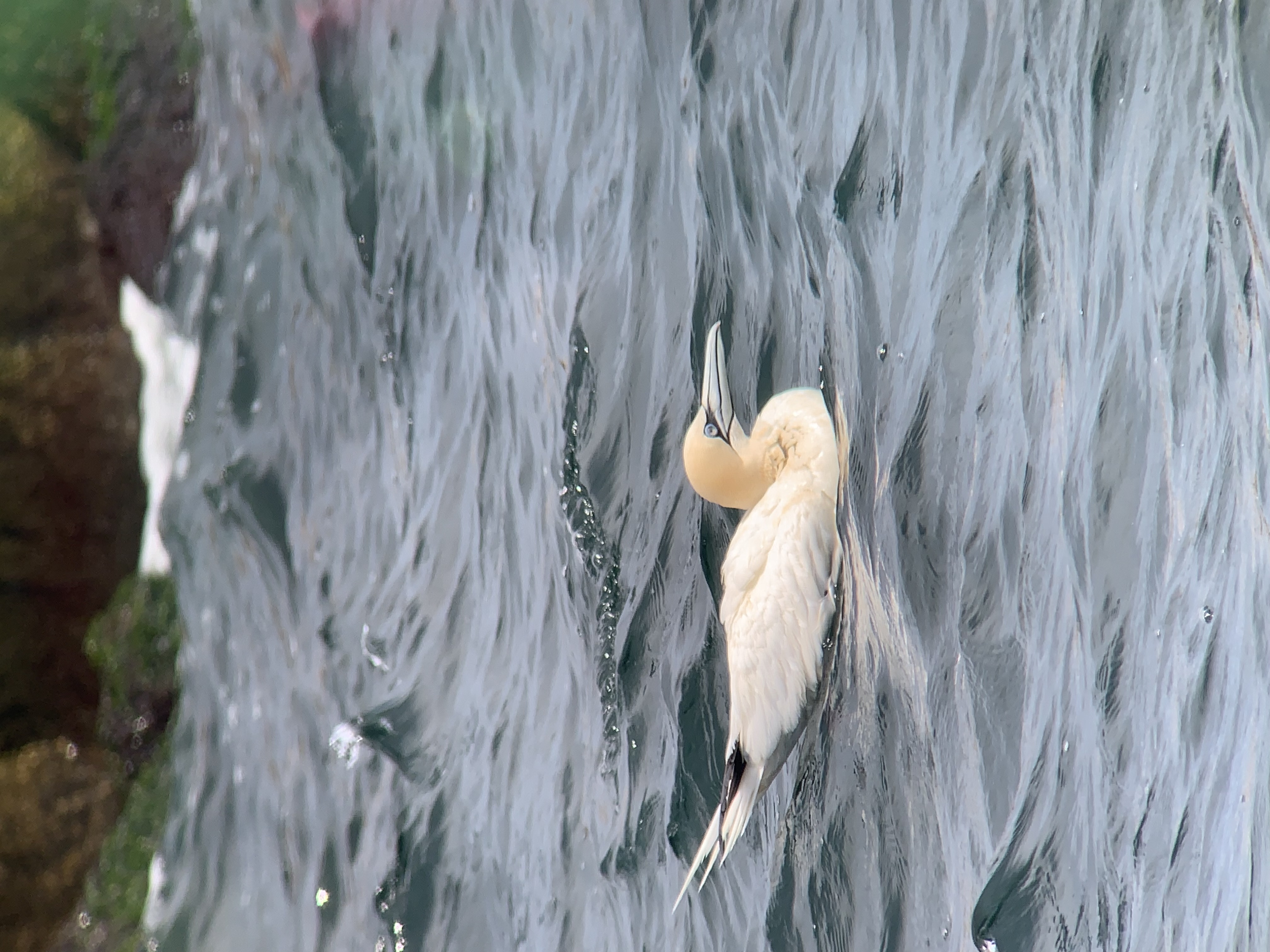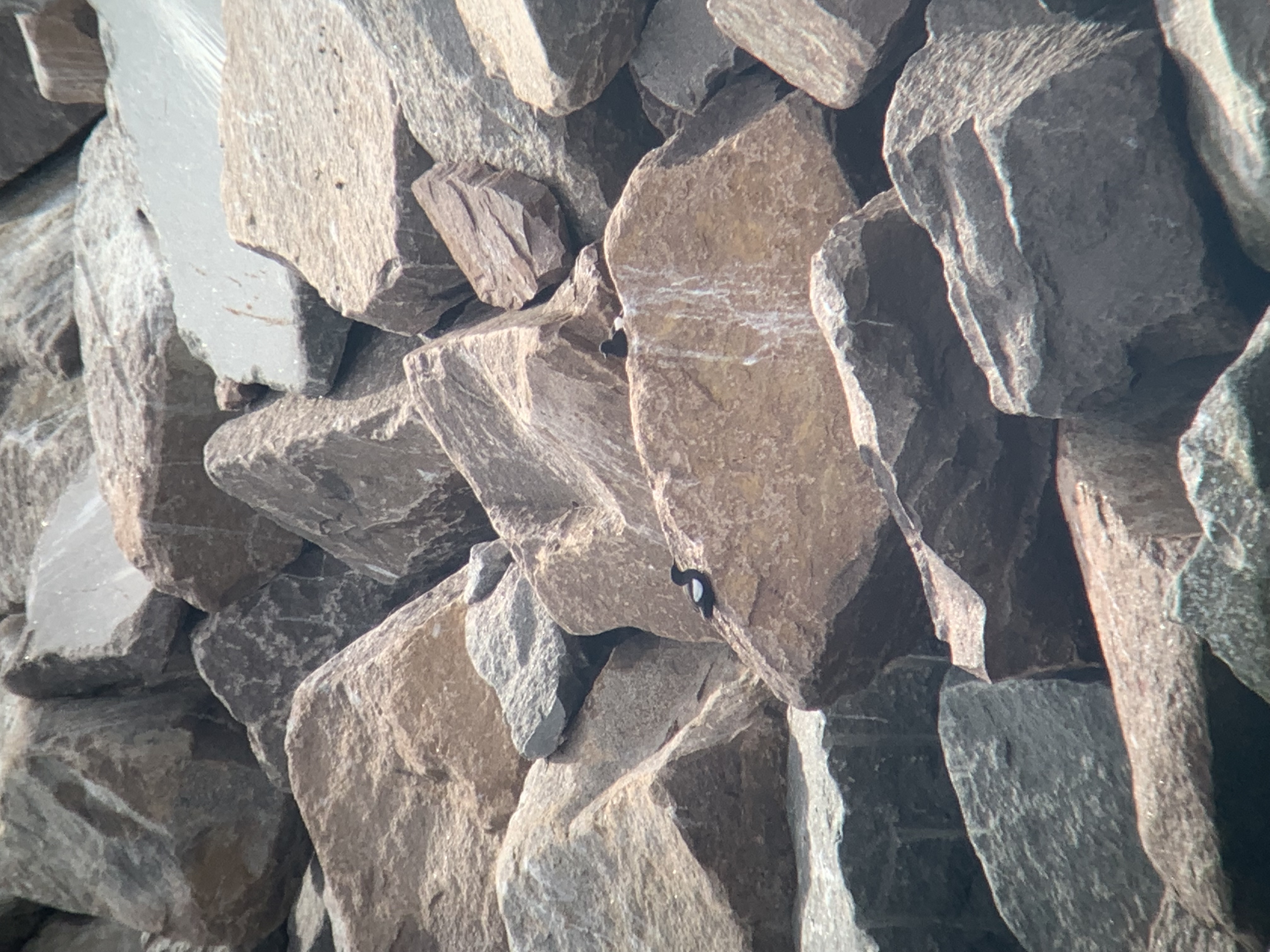Her på Skagen Fuglestations blog bringes korte nyheder i dagbogsformat om hændelser på fuglestationen.
People leaving – birds coming
The weather forecast had promised a cloudy day with little wind so I told everybody to get ready for a long ringing day with good numbers. Then the weather forecast in the morning, however, showed that the clouds were not real and it was going to be very sunny – and hot. So not so many birds expected after all. Which was good too, because Mathilde had a lot to learn and both Frederik and Taima were leaving this morning so having a bit more time to chill would have been nice.
Would have been, because the birds thought differently about that. No migration still but juvenile birds keep entering our nets as though this was the new trend sport for bird youth in Skagen. Just like yesterday we had more than 20 whitethroats (tornsanger). It really is good that we ring them otherwise we would never believe that it is really always different birds. There are sooo many of them! But that was not all for today. It was at 7, everything reasonably quiet, when I arrived at a net full of tits – great tits (musvit) and blue tits (blåmejse). I was alone only with Mathilde and there were at least 20 birds there so instead of putting them in bags I called everyone to come to these nets, take the rings and we just ringed them as we took them out of the nets. There were 13 juvenile great tits and 5 juvenile blue tits. We hope many of them will survive and we will see them again some time soon. And then we will also take the time to take the measurements, promised!
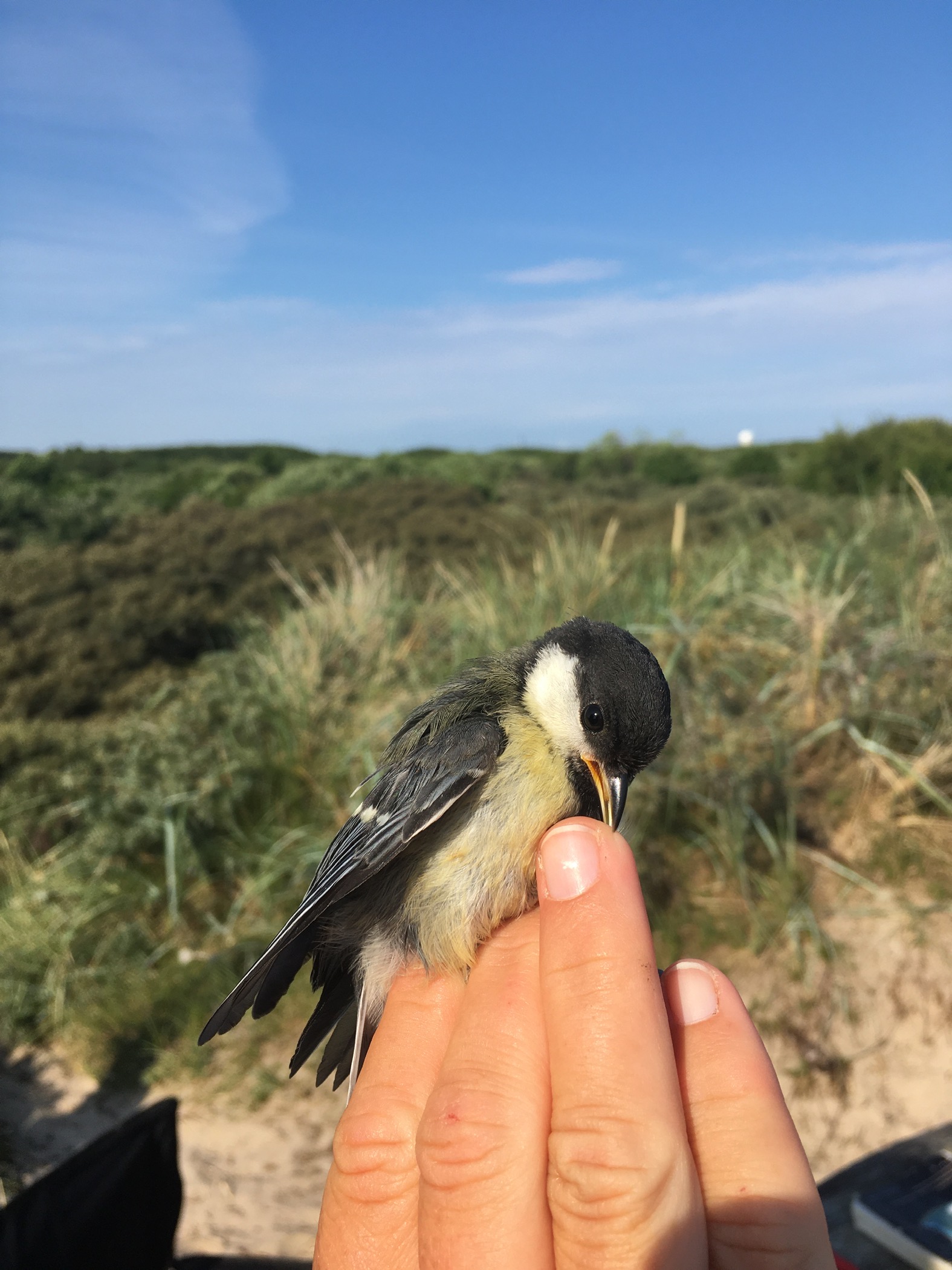
When we got back after our work at that net was finished (we were really quick working all together), there was a jay (Skovskade) waiting for me to ring it (because nobody else wanted to get bitten by it). What a pretty bird – and loud!
At around 9, Frederik and Taima left to go to Copenhagen. It was great to have both of them here. A bit sad that Frederik could not get us any exciting rarity this time but he promised to get one next year! And Taima will go ringing at Blåvand Bird Observatory for the next weeks, so hopefully she can use some of her new skills there. Mathilde in the meanwhile is learning very quickly and everybody at the station now has to change from spring to autumn plumage which makes the aging suddenly challenging again – just as we all had gotten a hang of it…
Next to having many birds today we also had a good variety, some birds we hadn’t caught in a while and mostly juveniles. We finally also had our first juvenile reed warbler (rørsanger) which we had been waiting for impatiently.
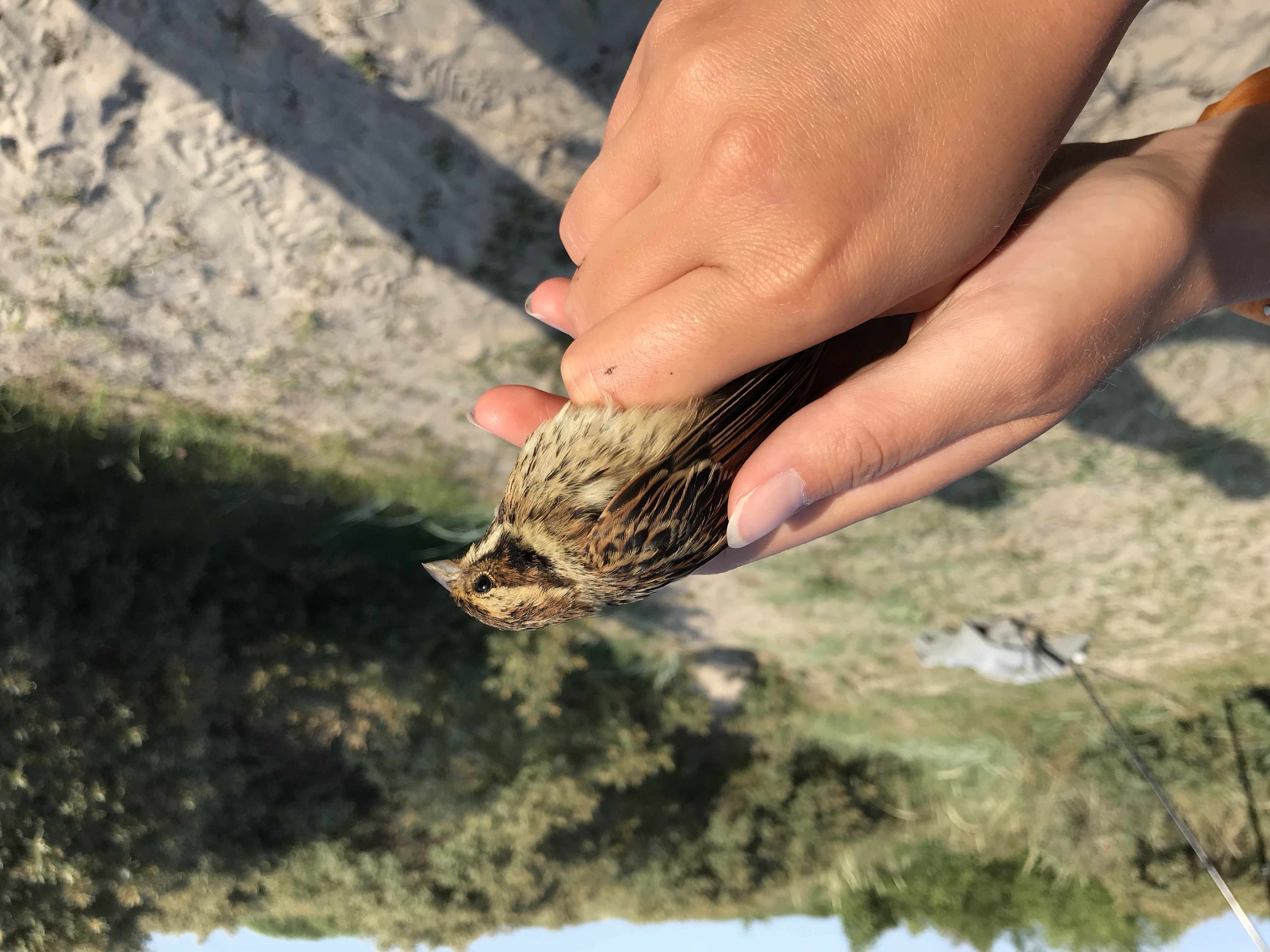
And a juvenile reed bunting (rørspurv).
After closing there was still some net fixing to be done and a lot of data entry. The rest of the day we just rested, went grocery shopping, had dinner and then go to bed early because tomorrow we have to go CES ringing again and we will go to see how the cormorants are doing.
Ringmærkning (Kabeltrommeln):
Husrødstjert 1
Solsort 1
Gærdesmutte 1
Gulbug 2
Havesanger 2
Munk 2
Tornsanger 21
Gransanger 5
Gærdesanger 4
Musvit 15
Blåmejse 5
Kærsanger 1
Rørsanger 1
Rødhals 1
Rørspurv 1
Skovskade 1
total: 64
Folk på stationen: Mathilde Ducroz, Frank Osterberg, Martina Hillbrand, Taïma Lorentzen, Frederik Johansen, Jesper og Margit.
Klik her for at se dagens observationer fra Dofbasen af fugle i Skagen.
Vandrikse og min sidste dag i Skagen for nu
Halløj derude
Dagen i dag startede i ringmærkningen. Martina åbnede netten klokken øv-bøv og jeg kom og assisterede hende med netåbning senere. I dag var en god dag i mærkningen, da vi fik hele 40 fugle i nettene! Hvoraf 22 af dem var tornsanger og 21 af dem ungfugle fra denne sommer. Så ringmærkede vi også en Vandrikse! En fugl fra denne sommer.
Under ringmærkning melder Rolf Christensen en rastende Brilleand (han) ud. En meget ventet art, som jeg blandt andet har kigget meget efter her de seneste par dage. Fuglen er formentligt en tilbagevenden fugl, som har været her de sidste tre år(?). Fuglen blev set ret godt, dog i lidt dårligt lys, men smuk var den. Omkring klokken 10:00 sagde vi farveller til Oskar og Jonatan, som smuttede tilbage til Sjælland i dag.
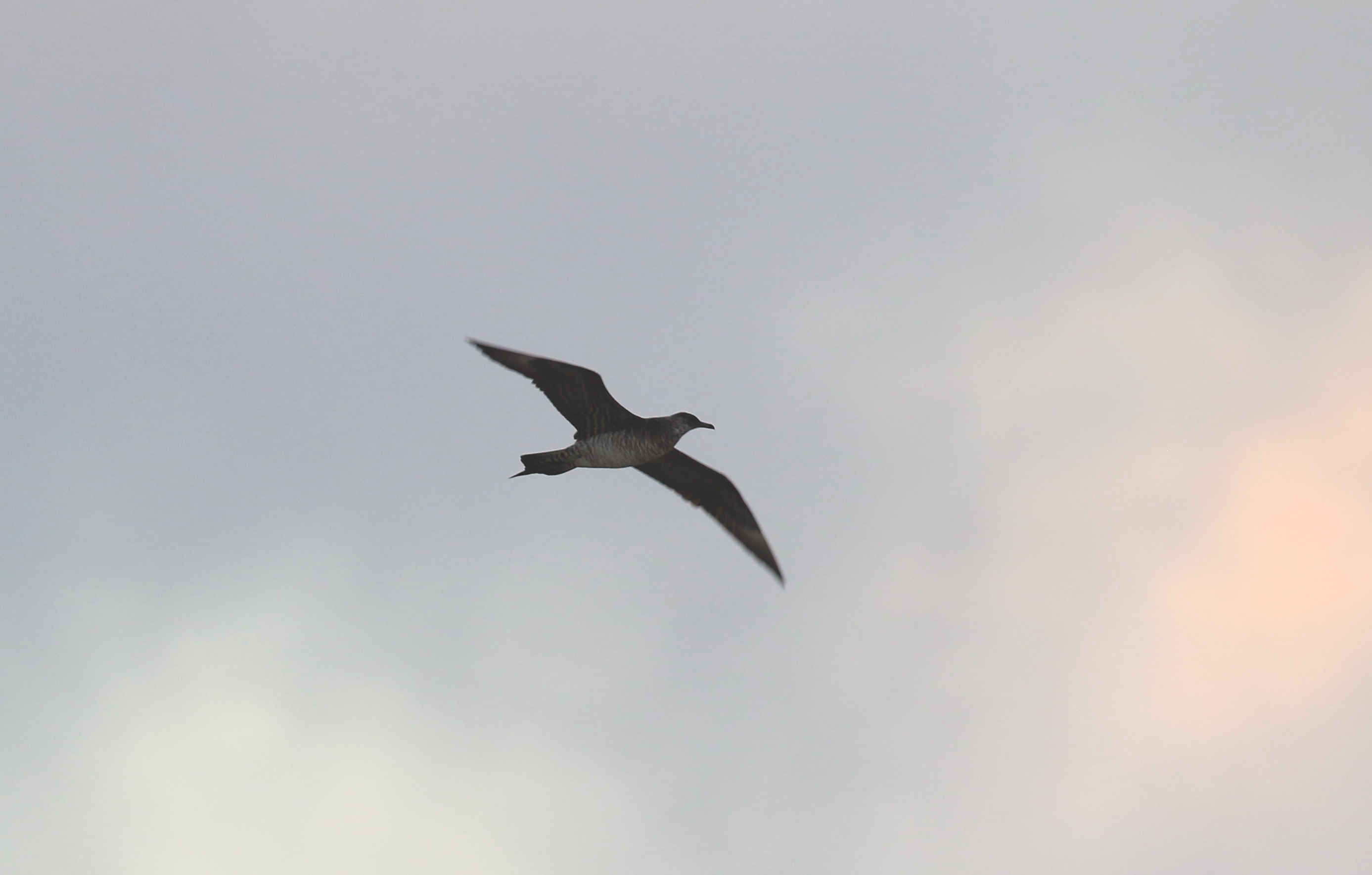
Almindelig Kjove fra Grenen i går
Efter vi havde lukket nettene, begyndte der at vise sig mange rovfugle ude i horisonten (som forventet), og så tog vi en beslutning om at drøne til Flagbakken. Vi kørte dog lige hurtigt hjem og smurte madpakker. Flagbakken gav en masse Musvåger (hvoraf en af dem var min Steppevåge/Musvåge-type fra forleden dag), et par Hvepsevåger, et par Spurvehøge og nogle Røde Glenter.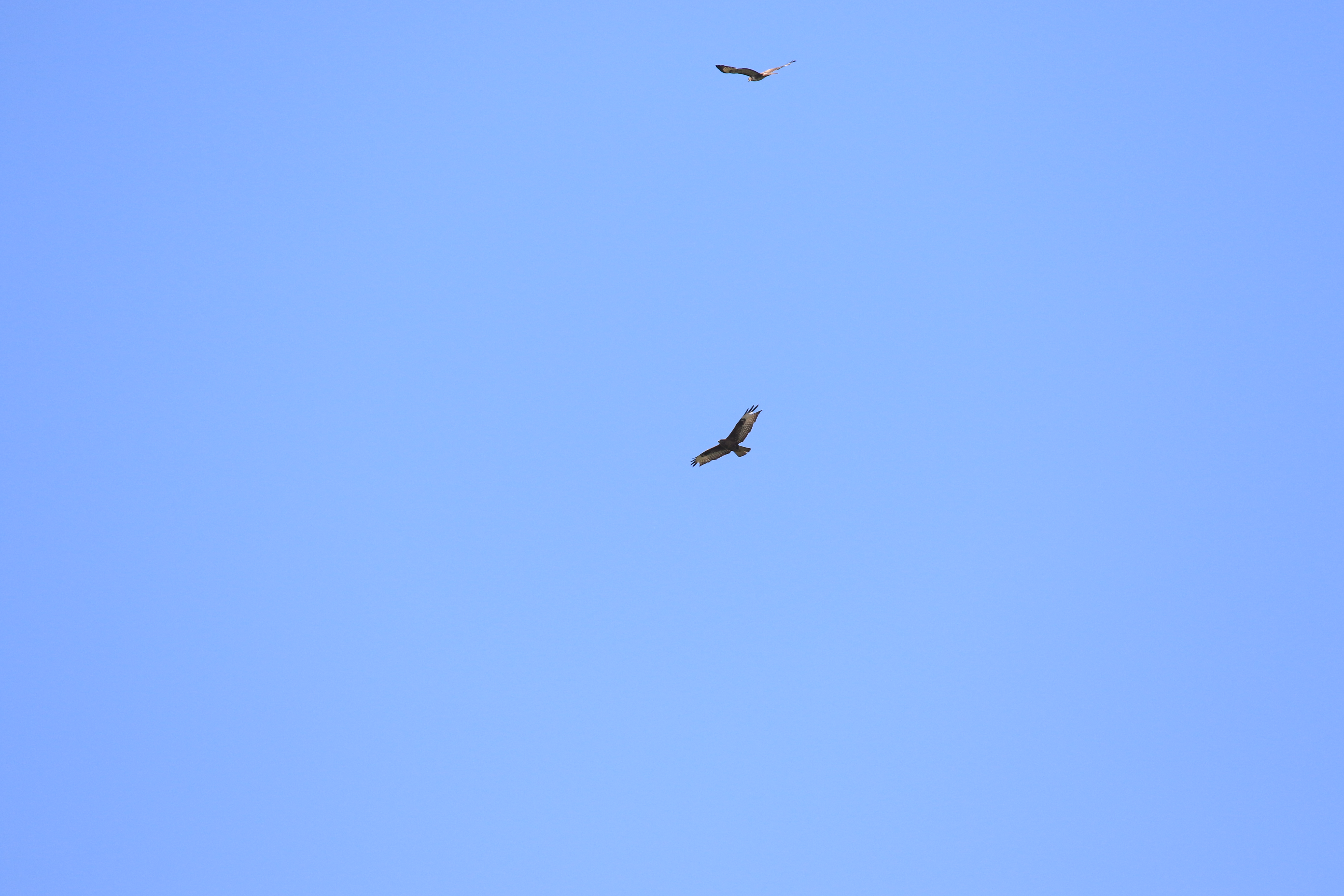
Steppevåge/Musvåge-type. Foto taget den 7/7, Nordstranden.
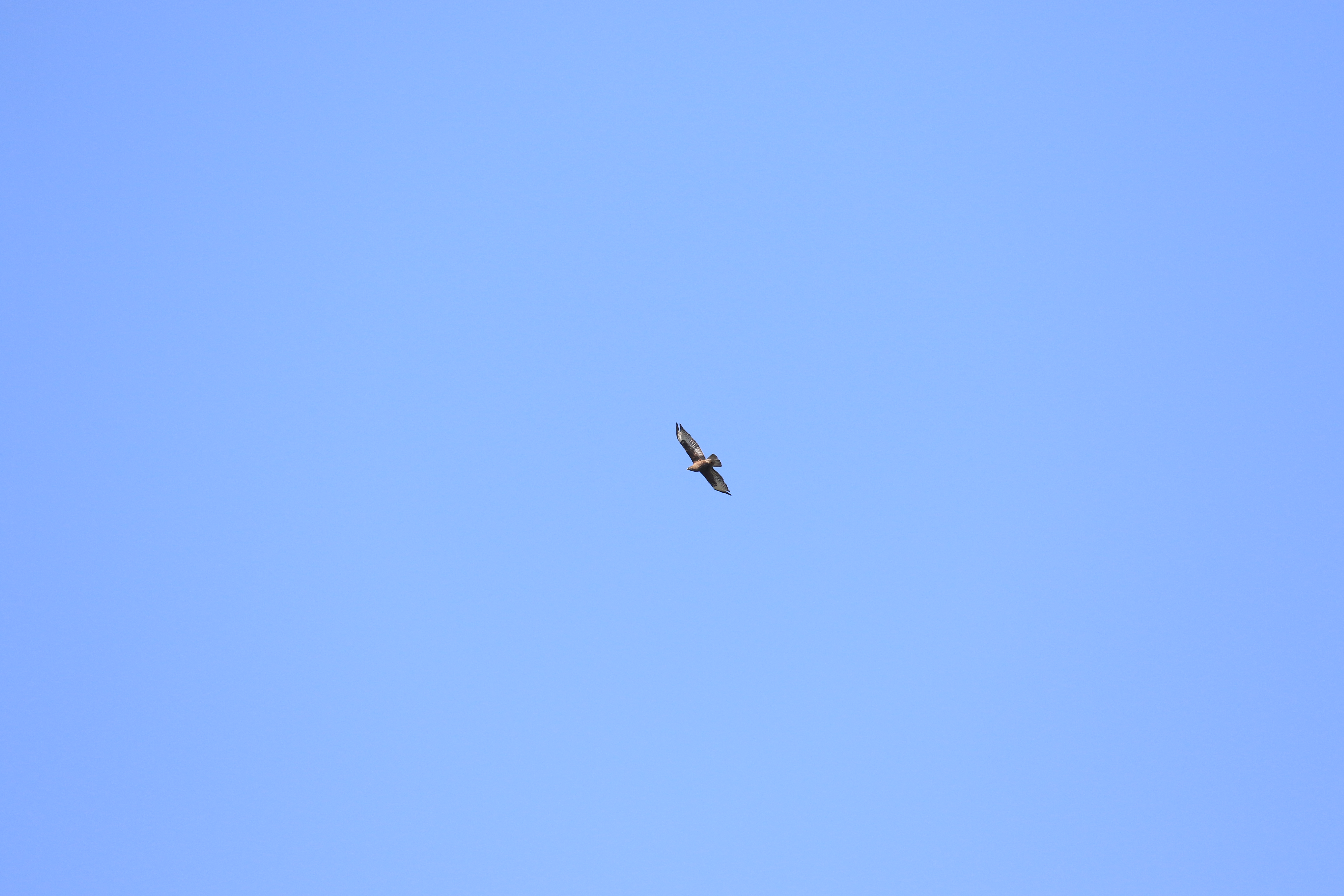
Steppevåge/Musvåge-type. Foto taget den 7/7, Nordstranden.
Rød Glente fra Nordstranden den 7/7
Efter Flagbakken kørte Taïma, Frank og jeg til Nedermosen for, at finde Traner til Taïma. Det lykkedes desværre ikke. Herefter kørte Frank og jeg hjem, og Taïma kørte ind i byen, på Museum! Og derefter købte hun lidt ind.
Martina var kørt hjem for at sove, og startede derefter på en masse praktisk stof.
Frank og jeg fik os en god lur på et par timer, og så har vi været i gang praktisk. Jeg er påbegyndt at analysere nattens natoptagelser.
Her til aften sagde vi velkommen til Mathilde, som skal være her de næste seks uger!
I morgen tager Taïma og jeg til Sjælland. Det har været fantastisk, som altid her i Skagen, og jeg kommer da halt sikkert snarest tilbage;)
På gensyn!
Ringmærkning (Kabeltrommeln):
Gulbug 1
Tornsanger 22
Gransanger 3
Gærdesanger 2
Musvit 5
Kærsanger 3
Rørsanger 2
Rødhals 1
Vandrikse 1
total: 40
Folk på stationen: Frank Osterberg, Martina Hillbrand, Taïma Lorentzen, Jonatan Pedersen, Oskar Zeeberg Nielsen, Jesper og Margit, Mathilde Ducroz og Frederik Johansen.
Klik her for at se dagens observationer fra Dofbasen af fugle i Skagen.
Crêpes og net vedligeholdelse
Godaften
Tidligt i morges tog Frederik til Grenen for at tælle fugle, og her så han Almendlig Kjove. Jonathan og Oskar kom lidt senere og blev længere for at se andre fugle. Jeg lavede pandekager en sisdte gang på fuglestationen.

Om eftermiddagen tog vi til Kabbeltromlen og Jennes sø for at sætte nye net op, og så håber vi, at flere fugle vil komme i nettene. Vi har også lavet lidt vedligeholdelse på de net, som allerede er på plads. Herefter tog Frank og jeg til byen for at få kaffe og kage og for, at jeg kunne blive testet. Jesper og Margrette er vores nye gæster, og de havde gulerodskage med til vores aftenmøde. Mange tak for det.
Nu hygger Frank og jeg på Blink terrasse med drinks og fodbold :)

Dette er min sidste blogpost her ! Tak til alle de fantastiske mennesker, jeg har mødt på stationen og Grå Fyr og på Blink. Mange tak til Simon for gæstfriheden og muligheden for til at komme til stationen. Tak til Michaela, Jonas, Mikkel, Esben og Rasmus for at have budt mig velkommen på stationen. Tak til Frank fordi, han har gjort sit bedste for at til lære mig om Rørfugle, og tak til Martina for at holde stedet i gang. Det var også dejligt at møde Frederik, Oskar og Jonathan. I var alle godt selskab, jeg har fået mange gode venner og lært meget af jer alle. Jeg håber til at se jer igen i fremtiden.
Folk på station : Frank Osterberg, Martina Hillbrand, Taïma Lorentzen, Frederik Johansen, Jonathan Pedersen, Oskar Zeeberg Nielsen, Jesper og Margit.
Hvid Vipstjert Unger
Today technically started last night, with attempted storm petrel (Lille Stormsvale) and roosting tern (Terner) ringing, although the chance for the storm petrels were low we still had hopes for the terns closer to sun rise. Everyone joined for opening the nets but after the first check of the nets, Jonatan, Oskar and Taima headed back. Martina brought her sleeping bag and had her best nights sleep since arriving here. Me and Frederik checked the nets each round however after a few net checks and the weather closing in we made the decision to close and head home. Once everyone was awake it was cleaning day! so everyone mucked in to get the communal areas, stairs and bedrooms nice and tidy and free of sand from the night before. Taima, Frederik and Martina entered some missing data, Taima also made a batch of brownies for everyone, and we rung the resident White wagtail (Hvid Vipstjert) chicks in the nest just below our window alongside the lighthouse. With help from Pierre and Kristina from the lighthouse centre and some interested visitors we had 6 healthy chicks and placed them back to hopefully fledge in the next week or so, where we will hopefully see them around the lighthouse showing off their new jewelry!
Tonight, (21:30-22:00) we will head out to Grenen point and north-beach to count the roosting terns and gulls (Måger) alike and possibly search for some color-ringed birds and hope for some interesting recoveries. The counts of which will be added below:
Lesser Black Back Gull - 33
Great Black Back Gull - 12
Blackheaded Gull - 54
Herring Gull - 265
Common/Artic tern - 136
Sandwich Tern - 14
Common Scoter - 21
Gannet - 10
Kittiwake - 2
Eider - 4
Curlew - 2
Dunlin - 4
Ringed Plover - 5
Red-Throated Diver - 1
Ringing :
6 Hvid Vipstjert unger
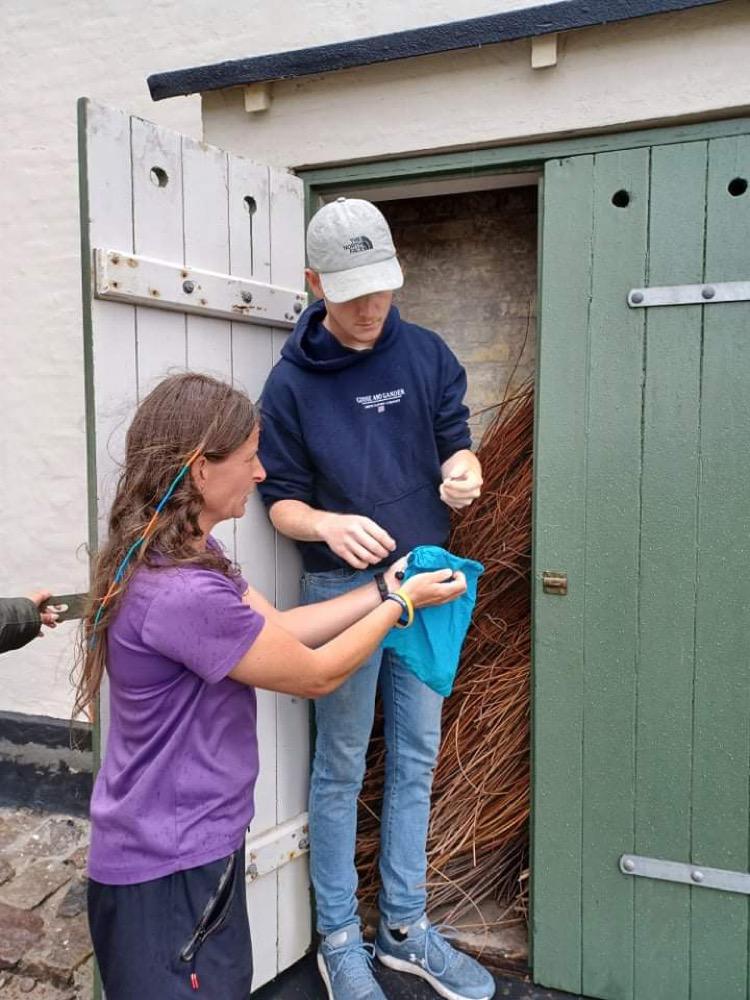
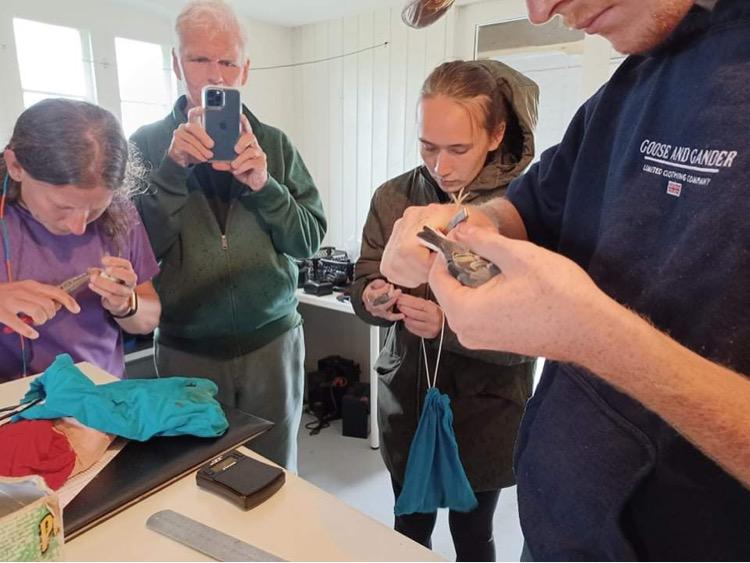
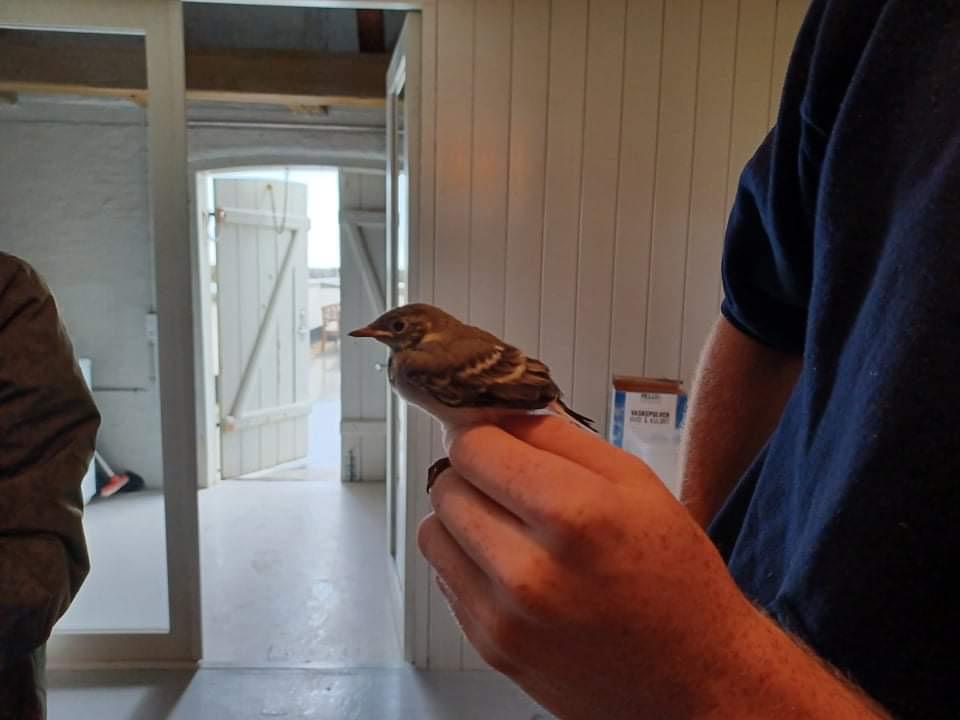
Ladies' night at nightjars
Today actually already started before yesterday was over. We left at 21.15 with Jørgen to Sandmilen where we set up the nets in the same locations as last time since they had proven successful. We were very early this time, so we had finished setting up the nets just before sunset even. I hadn’t expected anything to happen for another hour or so, but we had barely left the last net site when we heard a nightjar (natravn) sing. We stopped to look and actually got a good look at it sitting and flying. That was one of the first times I saw a nightjar in good daylight! It was a pretty male bird. So contrary to my initial plans to wait until it was getting reasonably dark, I turned on the playback already at 22:30. Then we had to wait. Our guests from the apartment also came to have a look, as it was Anders’ birthday and he was hoping for a very special birthday present.
We saw a nightjar here and there before the first net check but did not get a good view of another one. The first net check also did not produce any birds saw Anders and his family went home empty handed but on the way out they still managed to see at least one night jar properly!
The team that stayed back was rewarded with 3 nightjars on the next net check which was about 3 more than most of us had expected. It was two females and one male. It went quite quiet after that and there was a lot of waiting with very little reward (only one more female). The much hoped for morning peak did not come and so we went home with 4 nightjars ringed, meaning that we did not break our own record from last year but at least Jonathan, Oskar and Jørgen were happy because they had never held a nightjar before. It is quite unusual though to have more females than males in the nets and it shows quite clearly that the males are not really defending their territories much any more and the best time for catching them is over. The females are busy breeding now and should better not be disturbed in that so that we can have lots of baby nightjars in a month or two.
After we got home, I just went to the beach to check out our chances of catching terns there tonight. Chances are very small for sure but since it is supposed to be raining all day tomorrow and my sleeping rhythm is completely messed up already, we might as well go and try. We will see what happens.
After something like 4 hours of sleep I got up again to prepare for a ringing tour offered by the lighthouse this afternoon. There were only two visitors but some of our volunteers also joined and we caught definitely more birds than we normally do at this time of the day in the lighthouse garden so our visitors were very lucky and obviously happy. Frank was also happy because it was the first yellowhammer (gulspurv) we caught since he came here: a juvenile from this year - not as yellow as you would hope for, maybe...
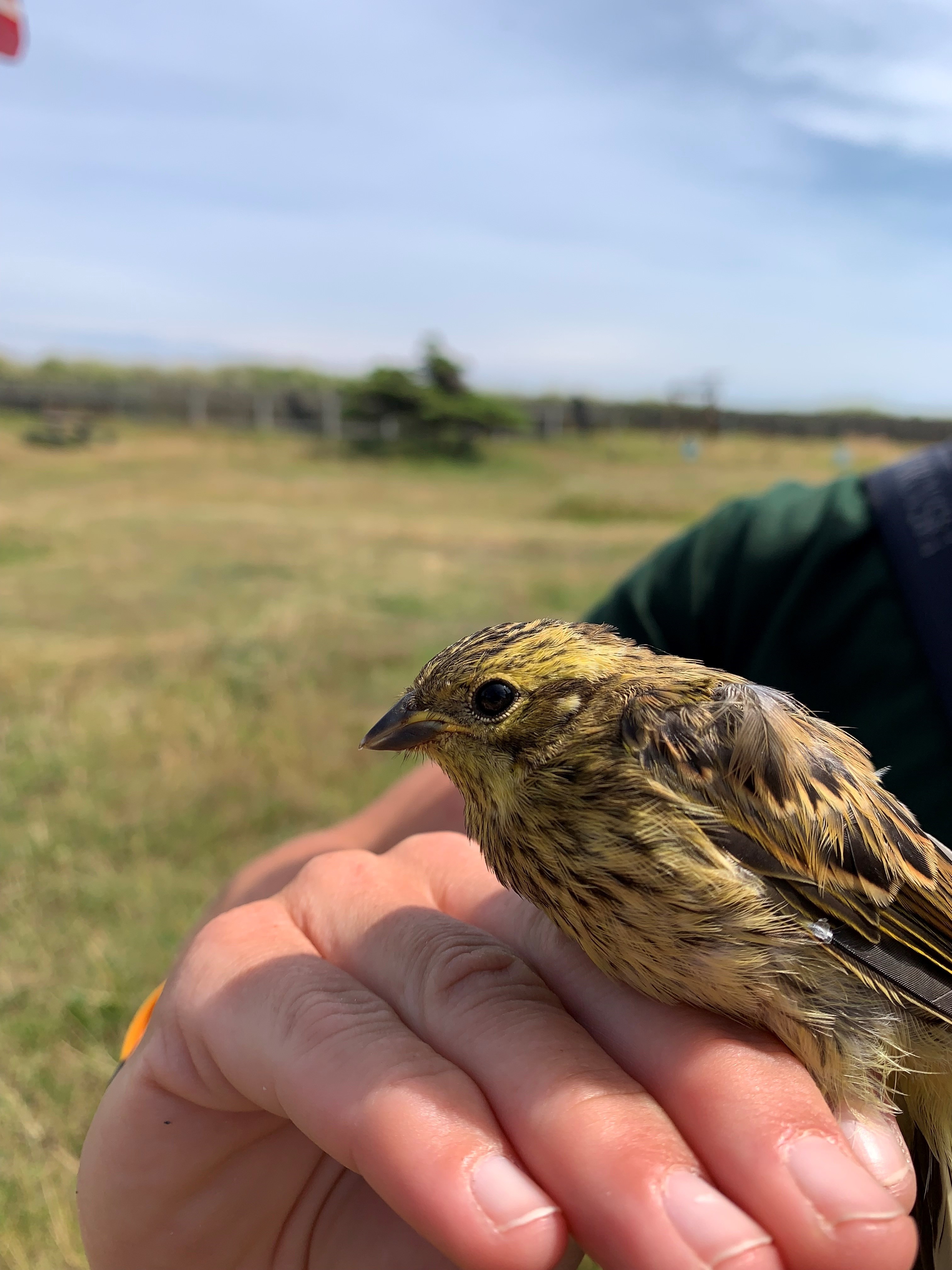
The most exciting thing for the rest of the day was Frederik trying to find a yellow-legged gull in a herring gull for half an hour without much success…
We will see what the night might bring.
Ringmærkning (Sandmilen) :
4 Natravn
Fyrhaven:
1 Gulspurv
2 Munk
total: 7
Folk på station : Frank Osterberg, Martina Hillbrand, Taïma Lorentzen, Frederik Johansen, Jonathan Pedersen, Oskar Zeeberg Nielsen, Jørgen Kabel, Anders Rasmussen, Anna-Mette og Dagmar
Klik her for at se dagens observationer fra Dofbasen af fugle i Skagen.
Bolde i målene og fugle i nettene
Hej alle
Dagen i dag kan kun stemples som godkendt, grundet en stor(omend omsiftelig) aktivitet og mængde af fugle. Det gjaldt både i nettene og i felten. Noget der gav energi og gåpåmod oven på gårsdagens fodboldkamp. Som titlen også antyder, går vi fugleinteresere ikke kun op i en en ting. En kendsgerning der i går (onsdag) kom til udtryk via vores priotering af fodboldkampen mod England. En process, der selvom den var spændende, blev lang. Det betød en sengetid efter kl. 12, på en dag hvor stationens beboere skulle op omrking kl. 4. En dyd, der normalt kræver at gå til lagnerne omkring 9-10 tiden om aftenen. Torsdagen har derfor været præget af stor træthed og lange middagslure. Det stoppede os dog ike i at gribe dagen og nyde den i fuglenes navn.
Ringmærkningen på Grenen gav forholdsvis hurtigt pote. Den blev udført i selskab af både Taïma, Frank, Martina, mig og en forstyrrende stor mængde myg. Her fangedes som sædvanlig massere af Tornsangere (Whitethroat), og snart sad der også Rørspurv(Red Bunting) og Gulbug (Icterine Warbler) i nettet. På sidste runde (ca kl. 10) ventede sågår også en engpiber (Meadow Pippit), på at blive reddet ud af sin indfiltrede skæbne. En fin afslutning på ringmærkningen i en lettere "tør" periode. Omkring kl. 6 sås et større "boom", hvor mængden af fugle eksplosivt steg. Det forudsagede at alle dagens ringmærkere fik fugle mellem hænderne, forholdsvis ofte. For mig betød dette, at jeg virkelig fik mulighed for at træne både håndteringen af fugle (forskellige greb, såvel som fedt, -og vingemåling), og databehandling (nedfælning af ringnummer og målinger). Alt i alt en fin dag, hvor mange fugle fik lov at passere igennem mig inden de slippedes løs.
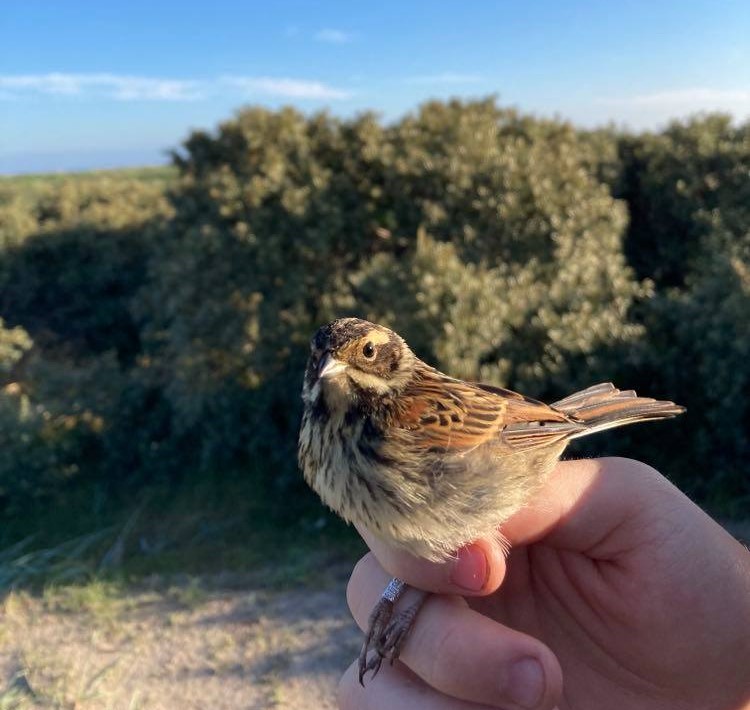
Rørspurv juv
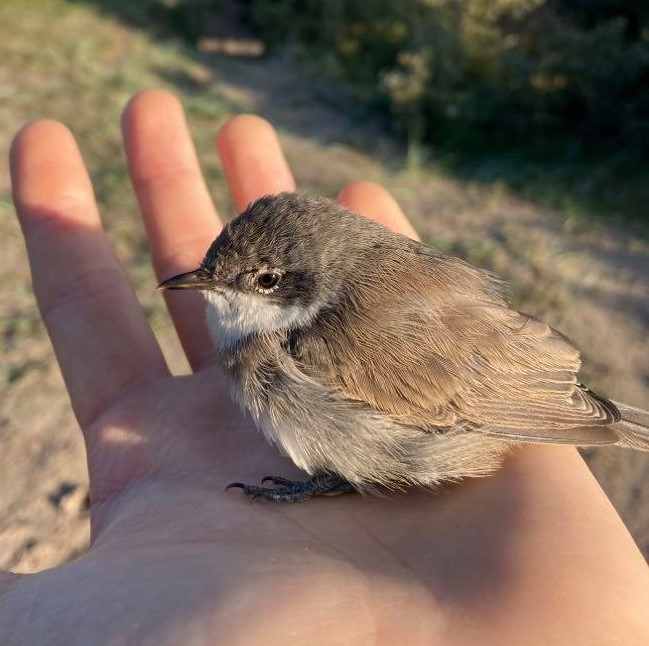
Unge fugle, kan let blive forvirrede, som denne Tornsanger, der ikke havde opdaget at den var fri og kunne flyve væk. Derfor sad den og ventede i et stykke tid.
Den anden arbejdsgruppe stod i dag for hav-obs (måge og terne-tælling) fra Grenen og senere rovfugle-tælling fra nordstranden. Sidstnævnte bød på både Røde Glenter(Red Kite), Spurvehøge(Sparrowhawk) og Musvåger(Common Buzzard), i et imponerende antal. Der var således et fint fremmøde af fugle på begge fronter i dag. Jeg tilsluttede mig derfor også Jonatan Pedersen og Frederik Johansens rovfugle-tælling, efter min ringmærkning nåede sin ende ca. kl. 10. En god ide, da vi både fik serveret Røde Glenter på nært hold, og jeg fik hørt en snært af den Karmindompap de to "obsere" også tidligere havde opdaget.
Eftermiddagen stod, som tidligere nævnt for mange af os på søvn, men der blev her også løbet små-ærinder. Det var bl.a. i form af Martina, der fjernede forstyrrende bevoksning på ringmærkningsruterne, eller uddeling af "flyers" fra Taïmas side. Torsdagen er dog langt fra slut, da den store afventede Natravne-mærkning stadig skal finde sted i aften. En oplevelse vi kommer til at dække i næste blog-indlæg.
Ringmærkningsdata (Kabeltromlen):
Gærdesanger 6
Gulbug 1
Gærdesmutte 1
Kærsanger 1
Tornsanger 10
Havesanger 1
Munk 3
Rørspurv 1
Bogfinke 1
Engpiber 1
Gransanger 1
Total: 27
Folk på station : Frank Osterberg, Martina Hillbrand, Taïma Lorentzen, Frederik Johansen, Jonathan Pedersen, Oskar Zeeberg Nielsen, Anders Rasmussen, Anna-Mette og Dagmar
Klik her for at se dagens observationer fra Dofbasen af fugle i Skagen.
Endnu en dejlig dag på Skagen fuglestation
Hej allesammen
I dag vågnde mig og Oskar op tidlig for, at være med til ringmærkningen, ude ved Jennes sø sammen med Martina og Frank. De første tre timer kom der kun meget få fugle i nettene og efter kl. 7, kom der nærmest ingen fugle i nettene. Men vi var så heldig at vi til sidst fangede en fin lille topmejse i nettet, hvilket var en dejlig oplevelse, og jeg fik lov til at ringemærke fuglen. Ude på ringmærknings stedet, så vi mange Musvåger og røde glenter, som træk syd på. blandet andet så vi måske en mulig steppevåge (Vulpinus )
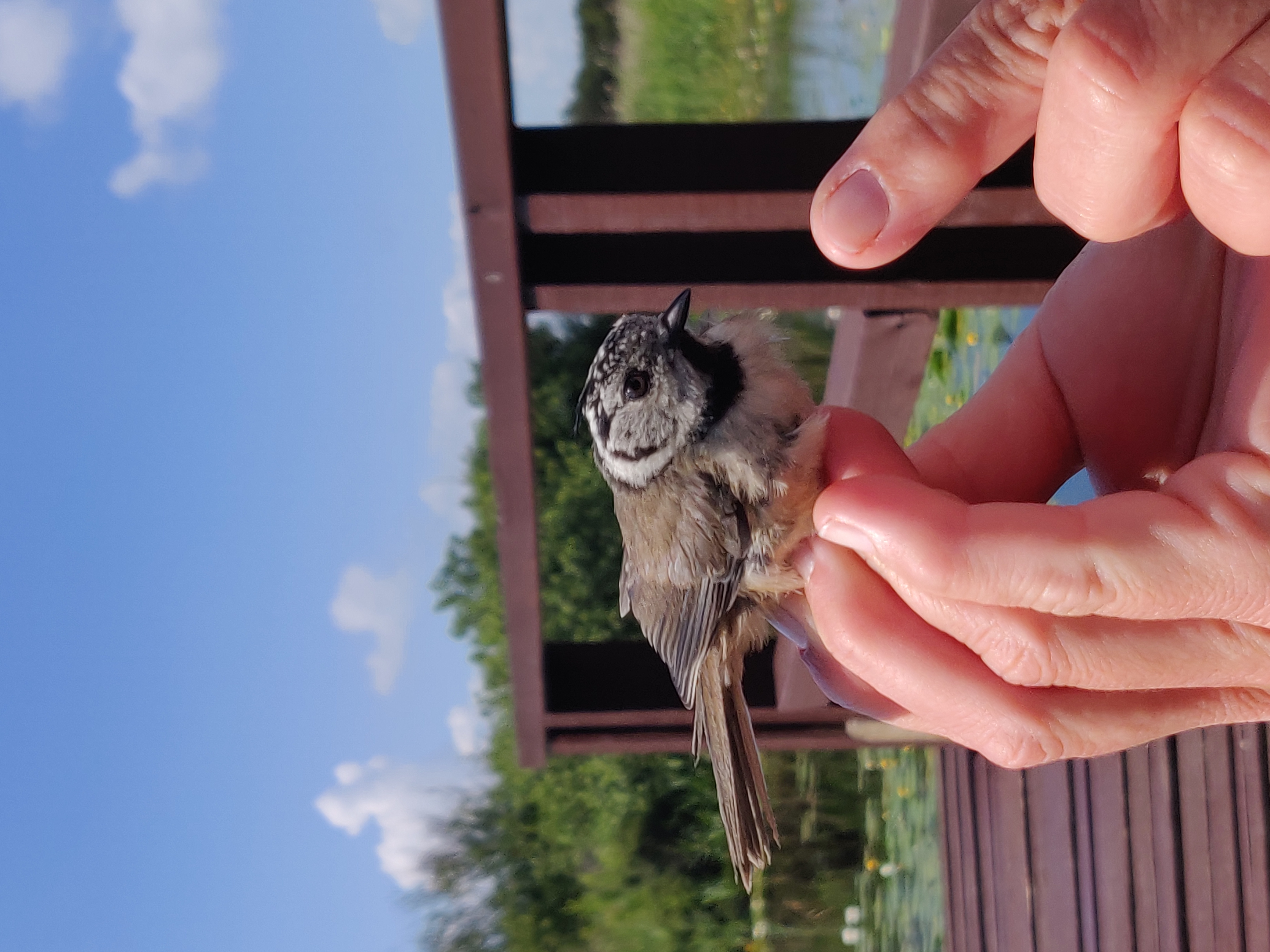 Taima og Frederik tog morgenobservationen, ude på Grenen tidlig morgen. De så også mange musvåger og rød glenter som trak syd på og nogle måger og terner. Stationslederen Simon Christensen så en hunfarvet Pirol lande i Elllekratet tidligere idag, der er stadigvæk mulighed for at den er der ude et sted.
Taima og Frederik tog morgenobservationen, ude på Grenen tidlig morgen. De så også mange musvåger og rød glenter som trak syd på og nogle måger og terner. Stationslederen Simon Christensen så en hunfarvet Pirol lande i Elllekratet tidligere idag, der er stadigvæk mulighed for at den er der ude et sted.
Hen på eftermiddagen gik jeg en lille tur for, at kigge på rovfugle, men så ikke rigtigt noget mega spændende. Derfter besluttede jeg mig til, at går op i det grå fyr, for at nyde den fantastiske udsigten og friheden, som tårnet gemmer på
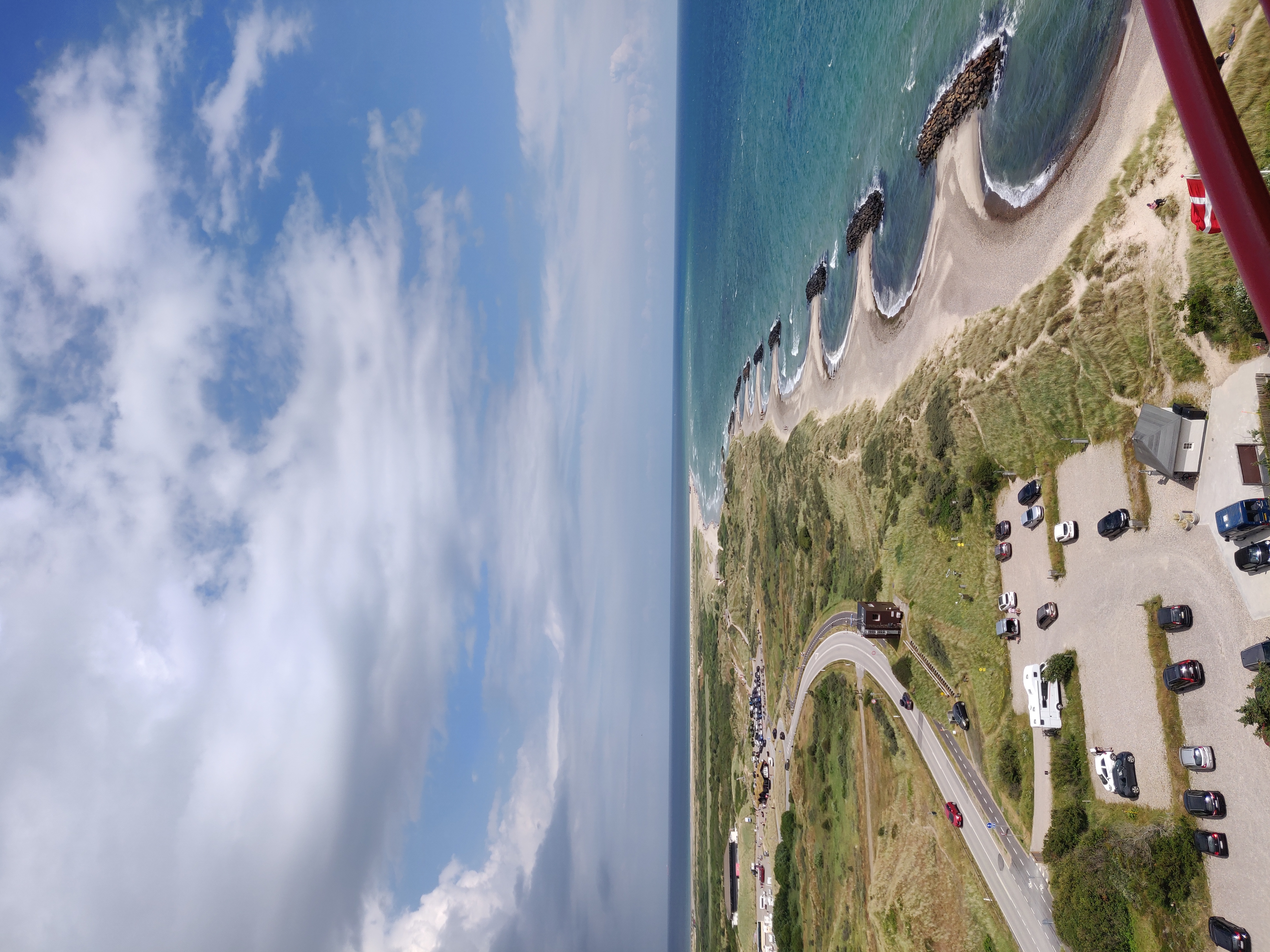
Ellers en meget stille og rolig dag i skagen, med en dejlig middagslur, lidt regn og sol. Vi håber på, at vi en af de kommende dage kan tage ud og ringmærke natravne, men det skal i nok høre mere om til den tid.
Ringmærkningen:
Topmejse 1
Bogfinke 1
Munk 1
Tornsanger 1
Gransanger 1
Gærdesmutte 1
Total 6
Folk: Martina Hillbrand, Frank Osterberg, Taïma Lorentzen, Jonatan Pedersen, Oskar Zeeberg Nielsen, Jonatan falke rumle Pedersen og Frederik Johansen, Anders Rasmussen, Anna-Mette og Dagmar
Klik her for at se dagens observationer fra Dofbasen af fugle i Skagen.
Pirol og dejlige fugle:)
Hej allesammen, så er jeg tilbage igen!
Oskar, Jonatan og jeg ankom til Stationen i går, og i dag var så vores første morgen. Martina og jeg åbnede nettene klokken tidligt, og Oskar og Jonatan kom til anden runde. Vi fangede i alt 33 fugle, ringmærkningsdataen står for neden.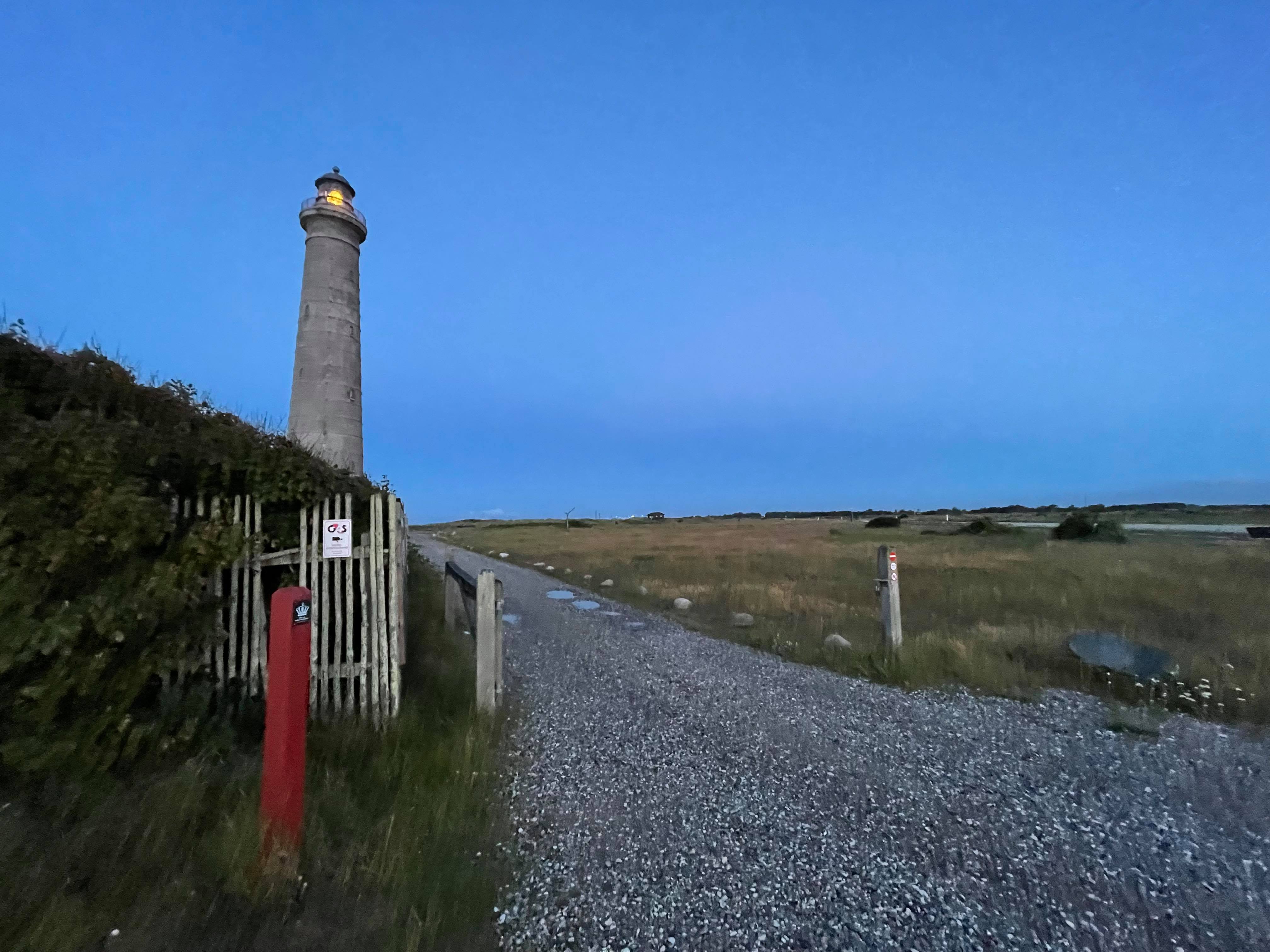
Under ringmærkning klokken 08:43 ser jeg en hun-farvet Pirol flyve mod Sardinkrattet, en fugl som nok lige har været på trækforsøg. Mega fedt! Første gang jeg finder en selv!!! Vi lukkede nettene klokken 11:40 og tog derefter jeg til Stationen. 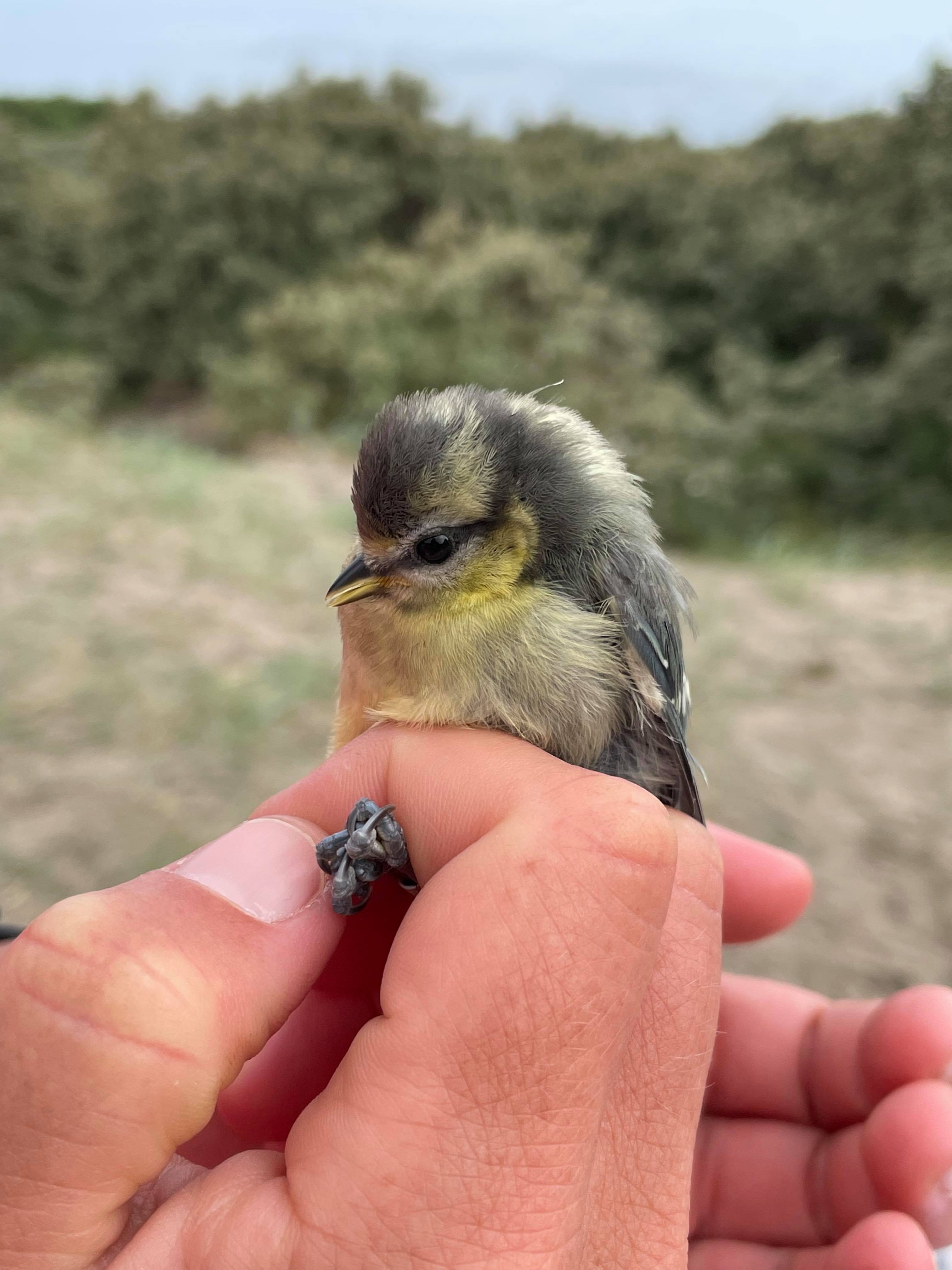
Taima tog først ud til Grenens parkeringsplads for at dele fliers ud for Det Grå Fyr. Taima fortsatte senere inde i byen, og hun endte ud med at have delt 135 fliers ud!!! Crazy!!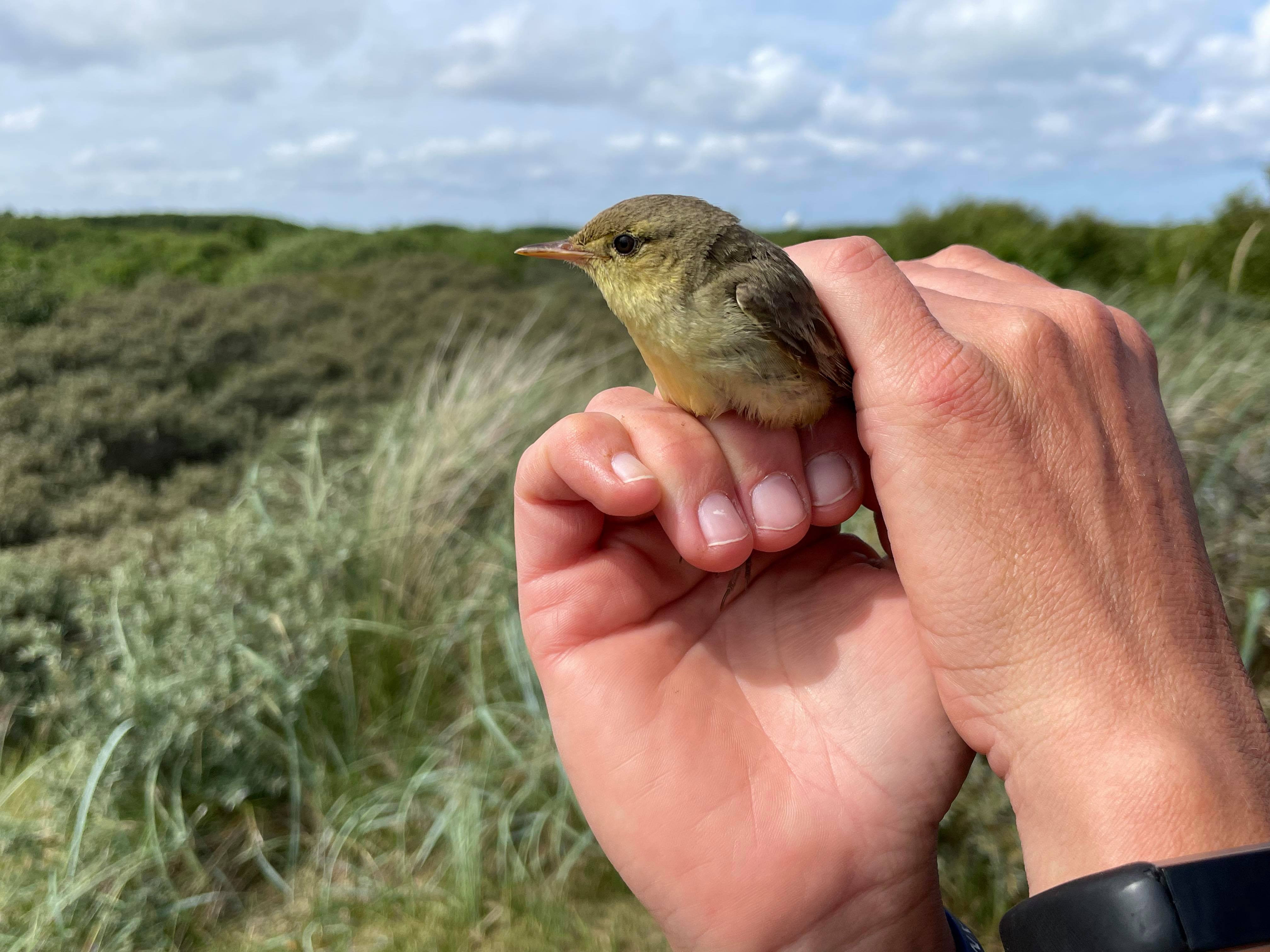
Til eftermiddag var der nogen af os som fik en dejlig lur, og så var det ellers en god cykeltur til Netto og Brugsen.
Ringmærkning (Kabeltrommeln):
Gulbug 1
Tornsanger 16
Bogfinke 1
Blåmejse 3
Gransanger 3
Gærdesanger 1
Løvsanger 1
Musvit 1
Kærsanger 1
Rørsanger 4
Rødhals 1
total: 33
Folk: Martina Hillbrand, Frank Osterberg, Taïma Lorentzen, Simon S. Christiansen, Jonatan Pedersen, Oskar Zeeberg Nielsen, Jørgen Kabel og Frederik Johansen.
Klik her for at se dagens observationer fra Dofbasen af fugle i Skagen.
Bjergvipstjert og en lille fugle oplevelse fra Havnen
Hej allesamen !
Højdeepunktet i ringmærkning var en flot 1k Bjergvipstjert, hans mor kaldte på ham da vi fandet ham i nettet, men hun blev ikke fanget i nettet.Vi har også fanget en 2k+ jernspurv, for nogle fugle er lidt svært til at bestemme deres alder på den tid af året,derfor må man sige 2k+, hvis man er ikke sikker på at det er en 2k eller 3k+ fugl.
Omkring 06:00 begyndte det at regne, så vi sluttede ringmærkning tildlig. Derefter gik vi til havnen, der så vi en mærkelig Sule i vand og et par Tejster. Vi var bange for at Sulen ikke var sund fordi den var meget passiv. Til sidst fløg den dog afsted, og vi fik taget nogle gode billleder.
Om eftermidaggen, ankom der 3 nye frivillige : Frederik Johansen, Jonathan Pedersen og Oskar Zeeberg Nielsen. Da de ankom, kiggede de gennem nogle af vores biblioteksbøgerne og tog på en lille Tur ud på Grenen. Derefter spiste vi dejlig Pizza med hjemmelavet pizza dej fra Martina.
Ringmærkning :
1 Bjergvipstjert
1 Munk
1 Jernspurv
1 Solsort
4 Tornsanger
2 Gærdesanger
1 Musvit
10 i alt
Folk på station : Simon S. Christiansen, Frank Osterberg, Martina Hillbrand, Taïma Lorentzen, Frederik Johansen, Jonathan Pedersen, Oskar Zeeberg Nielsen, Joern Kabel, Anders Rasmussen, Anna-Mette og Dagmar
Klik her for at se dagens observationer fra Dofbasen af fugle i Skagen.
Who needs sleep?
So, after having to move it because of the rain the night before we finally went out with Lars Bo to catch nightjars (natravn) last night. It was the perfect night and it did not take us long to also find the perfect spots to set up nets. While setting them up we heard two nightjars singing already. We had just finished setting up the nets when two guests arrived, Ida and her husband who had stayed in the apartment a while ago but hadn’t gotten to see nightjars so they came back only for this night. They also brought home-made chocolate cake and tea and coffee for us – what a treat!
The mosquitos weren’t quite as bad as expected so it was a fine night really. And it got even better when we were waiting for the first net check and a nightjar suddenly started flying about our heads like a bat. We got a great view of it and it was really only very few meters away. It was little surprise then to find another nightjar in the net at the first check. Even better, we found 2, a male and a female! So that and the cake kept us busy until about 1.30am when we caught the next male. After that, unfortunately, the speakers we use for luring the birds died and so Lars figured it wouldn’t make sense to stay. I didn’t mind getting back early because I still wanted to go ringing in Kabeltrommeln so we packed up the nets and left. Well, before we left we got an even better view of even more nightjars flying around. They are amazing birds, really! Like bats, just better.
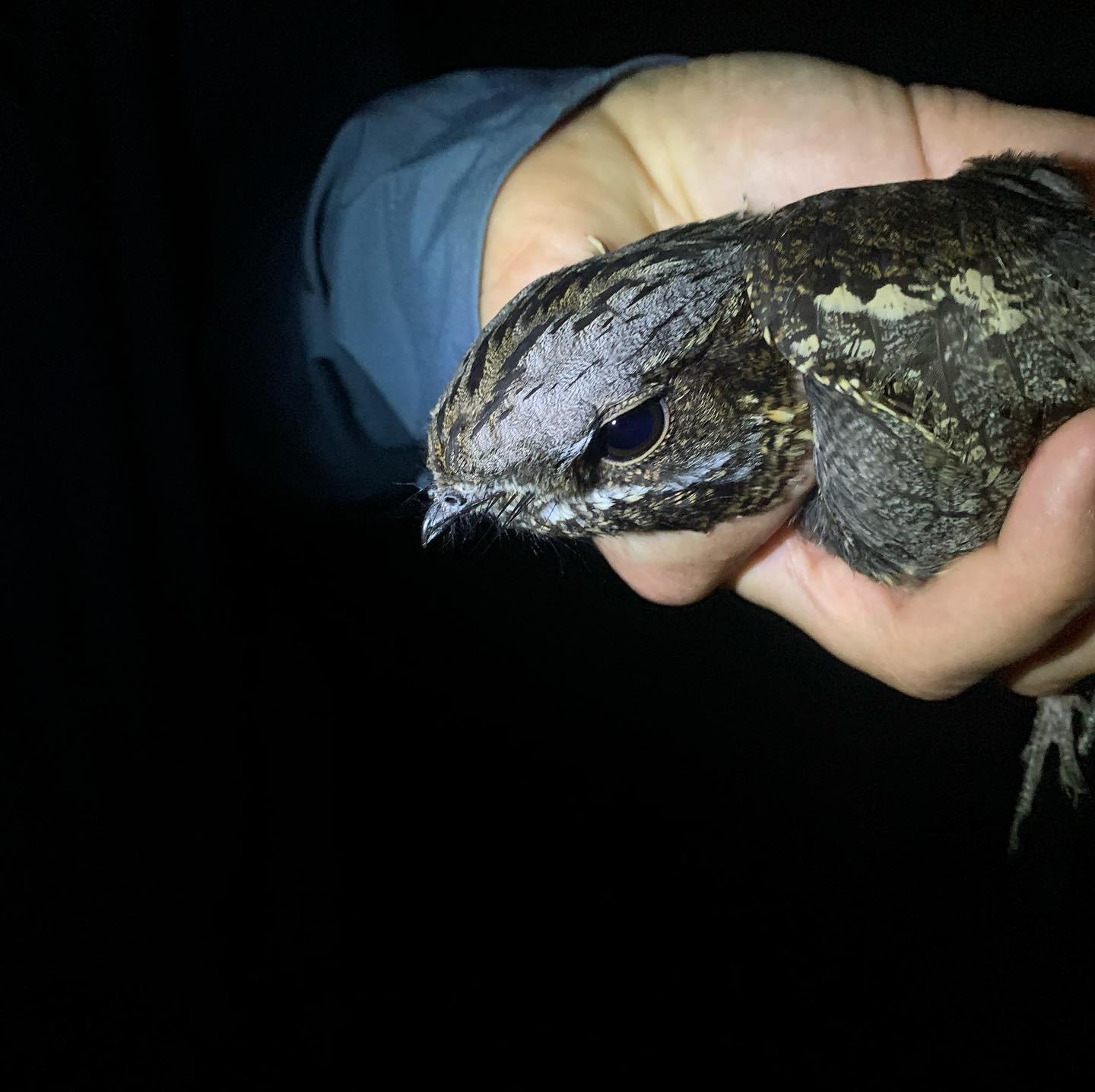
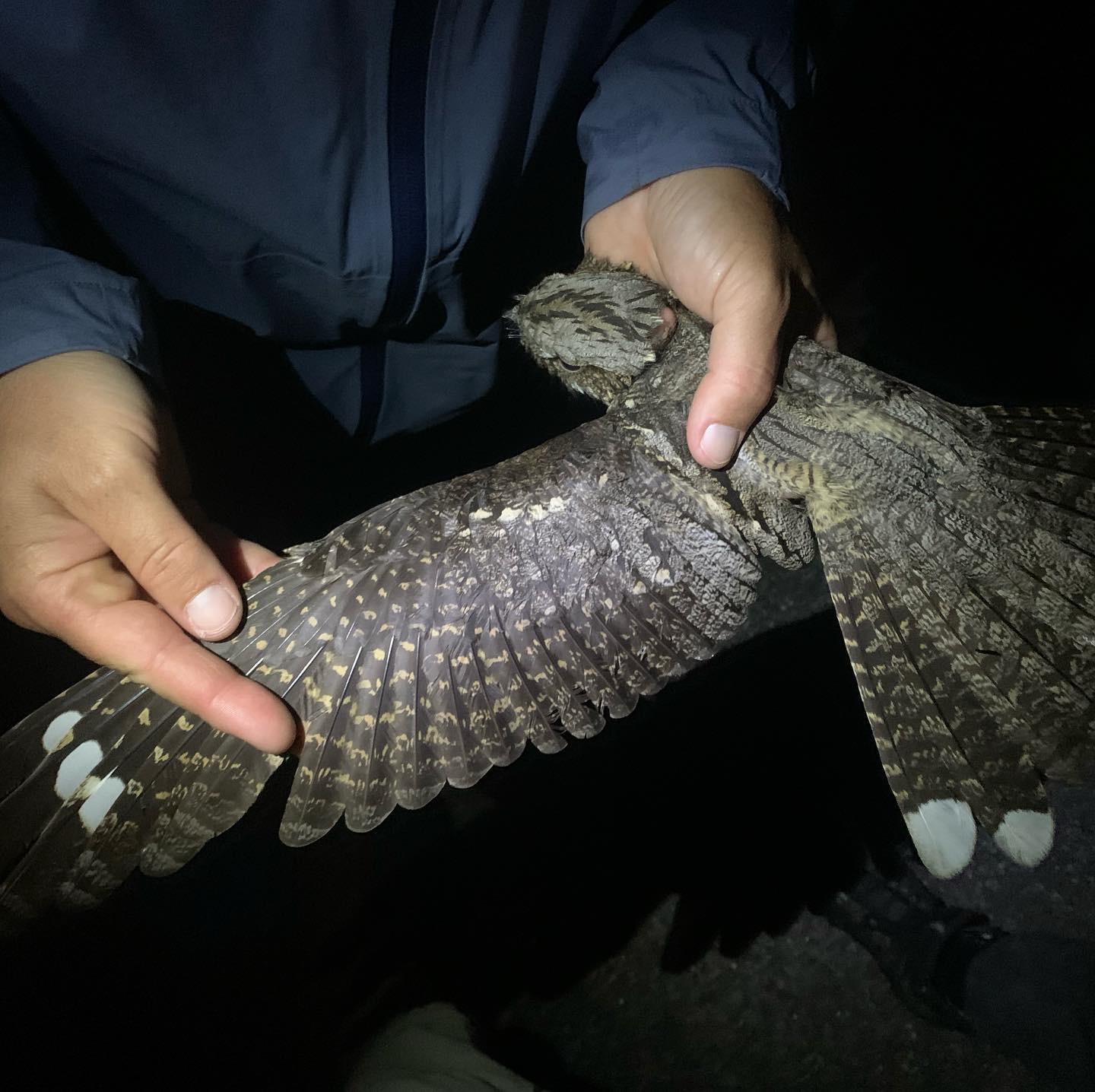
Thrushes were already singing when we left so we wouldn’t have stayed much longer anyway and so everybody was happy to go, also to get away from the mosquitos. Little did we know that the mosquitos at Kabeltrommeln were even worse than at Sandmilen today. The mosquitos clearly said it would be raining soon but the weather forecast didn’t and I believed the latter – common mistake committed be tech generation, I guess. Well, so we opened the nets at Kabeltrommeln and we did two net checks with very few birds when suddenly it started raining out of the nowhere and quite hard too. After checking four different weather forecasts we decided to close the nets and not risk anything seeing that we had been catching flocks of young birds lately and there was at least one flock of siskins (grønsisken) moving about the sites where we have the nets – one individual was caught. You don’t want a net full of them when it is starting to rain…
Back at the lighthouse we tried to catch up on sleep lost and then welcomed the new guests in the apartment. Anders, Anna-Mette and their daughter will stay with us for this week and hope for more nightjars.
Finally, Taima and me went to Skarvsøen for the cormorant monitoring. It is good to see that quite a few cormorant chicks are now as big and mobile as the adults and are therefore out of danger of predation. On the other side, we also saw a nest with 4 quite young chicks and a new nest with a female incubating. Unfortunately we do not know if the nest really is new or it has just been missed on the last few visits. It is also very unlikely that juveniles born very late in the year will survive so it is questionable if it is worth the effort but the birds don’t seem to calculate chances like that.
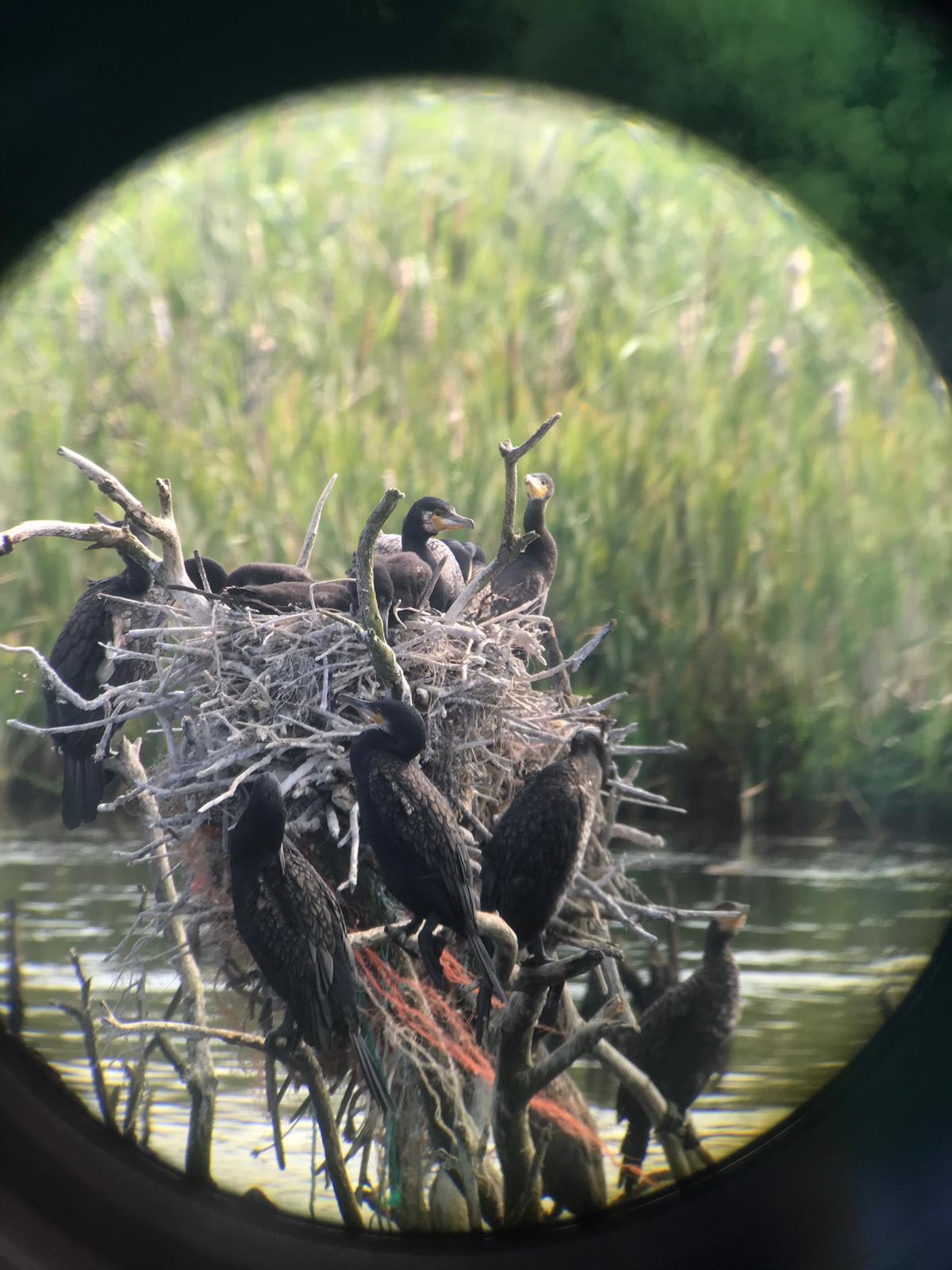
After a nice dinner made once again by our amazing chef from England, Frank, we went to bed early to be a little bit fresher for ringing tomorrow. See what the next week will bring!
Ringmærkning (Sandmilen):
Natravn 3
Ringmærkning (Kabeltrommeln):
Grønsisken 1
Tornsanger 3
Munk 2
total: 9
Folk: Frank Osterberg, Martina Hillbrand, Taima Lorentzen, Lars Bo, Anders Rasmussen, Anna-Mette og Dagmar
